Sea Grant has released an Oil Spill Science Fact Sheet pointing readers to a variety of oil spill science information sources for both general and specific research and response audiences.
The fact sheet is found here

Sea Grant has released an Oil Spill Science Fact Sheet pointing readers to a variety of oil spill science information sources for both general and specific research and response audiences.
The fact sheet is found here
Sea Grant has released an Oil Spill Science Outreach publication discussing examples of how oil and dispersants might affect Gulf of Mexico fisheries to help natural resource managers maintain healthy Gulf of Mexico ecosystems and protect the livelihoods of the people that depend on them.
The bulletin is found here
The Gulf of Mexico Sea Grant Oil Spill Science Outreach Program has created overviews of the GoMRI synthesis activities.
Sea Grant has released an Oil Spill Science Outreach publication discussing what happened to the oil that reached the Gulf of Mexico beaches in the aftermath of the Deepwater Horizon oil spill.
The bulletin is found here
Sea Grant has released an Oil Spill Science Outreach publication discussing how the Deepwater Horizon oil spill affected the mental health of some residents along the Gulf Coast.
The bulletin is found here
Sea Grant has released an Oil Spill Science Outreach publication discussing clean-up tools and techniques and decision-making factors related to oil spill response.
The bulletin is found here
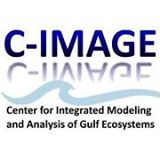 The Center for Integrated Modeling and Analysis of Gulf Ecosystems (C-IMAGE) is a research consortium of 19 U.S. and international partners focused on effects of oil spills on marine environments. The C-IMAGE consortium is currently in their second installment of funding from the Gulf of Mexico Research Initiative (GoMRI) in response to the Deepwater Horizon blowout of 2010.
The Center for Integrated Modeling and Analysis of Gulf Ecosystems (C-IMAGE) is a research consortium of 19 U.S. and international partners focused on effects of oil spills on marine environments. The C-IMAGE consortium is currently in their second installment of funding from the Gulf of Mexico Research Initiative (GoMRI) in response to the Deepwater Horizon blowout of 2010.
Education and outreach team leaders are Co-I T. Greely (USF) and Co-I L. Hotaling (USF), though all C-IMAGE investigators will have the opportunity to participate. The USF CMS office of Education and Outreach has a 20-year history in K-12 and graduate education and has five E&O programs, including the Oceanography Camp for Girls (OCG), Teachers Oceanography Workshops (In-TOW), OCEANS Teaching Fellowships, Spoonbill Ocean Sciences Bowl, and graduate courses for scientists and teachers on how to teach and communicate the ocean sciences to multiple audiences.
Reaching beyond the scientific and engineering communities, a robust education and outreach effort is planned to share C-IMAGE research with the general public. The multi-faceted education and outreach plan include formal, informal and citizen science education programs. The formal K-12 education program will highlight professional development (PD) for teachers involving:
The formal graduate education program will provide PD for marine science graduate students about teaching and communicating GOM ecosystem sciences in K-12, informal and public forums. The informal science education (ISE) program will include partnerships with aquaria and science centers to highlight data from C-IMAGE research in exhibits in their facilities, and a partnership with WUSF Public Radio to create a series of radio segments/podcasts, which explain in narrative format the research conducted through C-IMAGE. The citizen science programming will draw inspiration from The GLOBE Program where students and concerned citizens can contribute to scientific research in the Eastern Gulf of Mexico. Citizen science will also include engaging the public via public lectures, podcasts, radio series and science cafes.
View C-IMAGE-generated education products!
C-IMAGE Public Education and Outreach Site
Visit their social media pages….
![]()
![]()
![]()
![]()
C-IMAGE Overview Video:
The Consortium for the Molecular Engineering of Dispersant Systems (C-MEDS) is a research collaboratory involving 43 investigators from 22 universities in the US. The Consortium is based on the premise that dispersants are an essential aspect in the effective management and mitigation of large oil releases from deep ocean environments.
A key aspect of the Consortium’s activities will be a coordinated education and outreach program. This will involve research experiences for undergraduates, a teacher training program that will bring knowledge of dispersant technology to K-12 education, and strong efforts for community outreach to inform local communities about the science and implications of dispersant use. A coordinated summer research program will be implemented that is modeled after the Louis Stokes Alliance for Minority Participation in Research Program.
 The Dispersion Research on Oil: Physics and Plankton Studies (DROPPS) consortium brings together complementing experts from seven institutions in order to investigate and model several key processes involved with the dispersion of oil spills and interactions of oil with marine organisms. The experimental and numerical studies will be performed at varying scales and levels of complexity, from bench-top studies that characterize specific phenomena to meso-scale experiments that are essential for mimicking realistic physical and biological conditions. We will investigate the breakup of crude oil patches into droplets, and the resulting droplet size distributions under several important conditions, such as sub-surface plumes, under breaking waves, and in turbulent flows.
The Dispersion Research on Oil: Physics and Plankton Studies (DROPPS) consortium brings together complementing experts from seven institutions in order to investigate and model several key processes involved with the dispersion of oil spills and interactions of oil with marine organisms. The experimental and numerical studies will be performed at varying scales and levels of complexity, from bench-top studies that characterize specific phenomena to meso-scale experiments that are essential for mimicking realistic physical and biological conditions. We will investigate the breakup of crude oil patches into droplets, and the resulting droplet size distributions under several important conditions, such as sub-surface plumes, under breaking waves, and in turbulent flows.
Complementary fundamental studies will focus on characterizing and modeling complex interfacial processes that cause the breakup of droplets in the presence of dispersants and bacterial colonies. Measurements will be performed with several oil properties and origins, as well as with varying concentrations of dispersants. We will measure and model the transport of oil droplet in turbulent flows, including settling and dispersion/diffusion rates, their encounter rate with marine particles and bubbles, and the effect of attachment to particles on agglomeration and subsequent transport of the petroleum. The interaction of oil with hydrocarbon-degrading bacteria at oil-water interfaces will also be investigated, including formation and growth colonies on surfaces, consumption rates, genetic traits of oil consuming bacteria and resulting changes to the oil properties.
We will also investigate, quantify and model the interaction of suspended oil droplets and surface oil patches with several species of marine phytoplankton and zooplankton, and with natural plankton assemblages, quantifying how planktonic organisms interact with minute oil droplets, their consumption of oil droplets and effects of these plankton on the fate of this dispersed oil. The results will be incorporated into a meso-scale model for predicting the transport and fate of oil spills. The studies will be performed in a series of specialized facilities that vary in scales from microfluidic cells and small plankton chambers, to intermediate facilities designed study specific physical phenomenon, and to large wave breaking tanks.
The measurements will be performed using state-of-the-art analytic instruments, as well as advanced three-dimensional imaging techniques. These studies are designed to provide data sets/predictive models to assess the dispersal and fate of oil spills in the Gulf of Mexico.
View DROPPS-generated education products!
DROPPS Education and Outreach Site
Visit DROPPS’s social media pages:
![]()
![]()
DROPPS Overview Video:
The Ecosystem Impacts of Oil and Gas Inputs to the Gulf (ECOGIG) consortium is committed to communicating its experience, observations, research, and data with other researchers, scholars, students, and the public through educational and outreach endeavors. The principal investigators engage students—from undergraduate to postdoc levels—in their research, assisting them in furthering their knowledge of the intricacies of the subject as well as the procedures. Inclusion on research cruises is a critical component in this educational process, as are internships.
ECOGIG researchers take advantage of formal educational opportunities to teach students, scholars, and colleagues about the Gulf of Mexico system, the impacts of oil and gas—naturally occurring and accidental—on the system, their research in the Gulf, and their findings from that research. Students of all levels—from kindergarten through doctoral—benefit from classroom presentations.
Similarly, the public benefits from presentations relating to ECOGIG work. Talks, seminars, museum programs, and exhibits are just some of the ways the researchers deliver their information.
Another avenue to the public’s attention is media coverage. Many of the ECOGIG researchers have been in the public eye since the Macondo well blowout in 2010. The demand for their expertise, opinions, and insights on matters pertaining to the Gulf and oil spills remains high and is reflected in newspaper articles, online blogs and articles, radio and TV interviews, etc. Press releases and interviews upon the publication of a relevant paper are common.
Multimedia communication is yet another way ECOGIG investigators reach students, colleagues, the media, and the public. Some of the researchers maintain their own blog, particularly during a research cruise, and some non-ECOGIG individuals blog about ECOGIG cruises. All of the researchers have a website presence, and most have coverage of their ECOGIG work, with links to this ECOGIG site as well as the GoMRI website.
And this website provides educational content throughout, as well as teaching materials.
View ECOGIG-generated education products!
ECOGIG Education and Outreach Site
Visit ECOGIG’S social media pages:
ECOGIG Overview Video
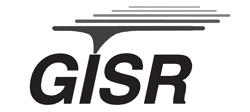
Gulf Integrated Spill Response Consortium
The vision of the Gulf Integrated Spill Response Consortium (GISR) is to understand and predict the fundamental behavior of petroleum fluids in the ocean environment. This capability is critical to inform decisions during response to oil spills and for development of mitigation plans, ultimately yielding significant environmental and financial savings. The Mission of this proposal is to develop a multi-scale modeling system validated by field and laboratory experiments to track the pathways of transforming hydrocarbons released from deep oil spills in the Gulf of Mexico. Our approach will be to conduct a multi-scale suite of field and laboratory experiments that target critical deficiencies in our understanding of the physical, chemical, and biological behavior of petroleum fluids as they transit the Gulf from a deep oil spill to the beach, marsh, estuary, or atmosphere, and to synthesize this understanding through the application of a validated, multi-scale numerical model of petroleum fate and transport in the Gulf.
The unprecedented scale of the Deepwater Horizon oil spill highlighted a critical need to understand the important processes affecting fate and transport of petroleum fluids over the wide range of scales, from the wellhead to the beach, in the Gulf of Mexico and to assess the benefits of potential spill response activities. This consortium proposal focuses on evaluating the mechanisms controlling fate and transport of oil in the Gulf of Mexico through laboratory, field, and numerical experiments.
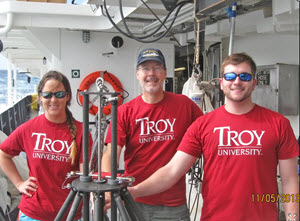
Ceil Martinec, Stephen Landers, and Craig Schimmer pose with the multicorer they use to retrieve sediment samples from the Gulf. (Photo courtesy of Stephen Landers)
Ceil Martinec picks microscopic creatures out of mud collected from deep in the Gulf of Mexico. She is looking for possible lingering effects of the 2010 oil spill on sediment-dwelling animals and making some exciting discoveries along the way.
“We are documenting new species for the area and studying the natural links or relationships between new and known organisms and their surrounding environment,” she explained.
Ceil recently earned her master’s degree in Environmental Science at Troy University and completed her thesis as a GoMRI Scholar. She was a research team member on the project Analysis of Continental Shelf Meiofauna in the Northern Gulf of Mexico: Effects of the Deepwater Horizon Oil Spill Investigated during a Long Term Community Study. Ceil shared her journey from the heart of Texas to the Gulf’s deep waters.
Her Path
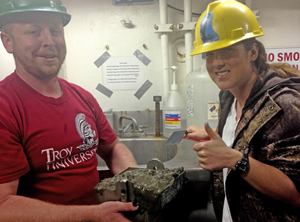
Ceil and lab mate Jonathan Miller display the sediment they collected for their meiofauna research. (Photo courtesy of Ceil Martinec)
Ceil grew up landlocked in Fort Worth, Texas, but she always found the ocean fascinating. Her father worked as an offshore welder, and the tales of his experiences at sea fueled her interest.
She accepted a soccer scholarship to Troy University in 2007. As a member of the athletic program’s leadership council, Ceil participated in community service and fundraising events and volunteered as a local high school soccer coach, all while earning top grades academically. There she met Dr. Stephen Landers, Professor of Biological and Environmental Sciences, who was impressed with her work ethic and influenced her decision to major in marine biology.
Ceil completed her undergraduate studies, then worked for two years as a NOAA fisheries observer. She boarded commercial fishing vessels in the Gulf and Atlantic Ocean, collecting data on fishing gear, catch and discard rates, target and non-target species, and interactions with marine mammals and sea turtles. She also educated fishermen on regulations and handling protected species. Landers, who regularly collaborates with NOAA, contacted Ceil in 2013 and asked if she would consider graduate school and assist him with his GoMRI-funded oil spill research.
Her Work
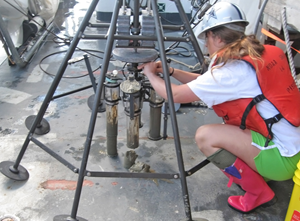
Ceil takes sediment samples from a multicorer during a NOAA cruise in November 2013. (Photo credit: Stephen Landers)
Ceil and the Landers’ team are studying meiofauna in the northern Gulf of Mexico continental shelf. They are documenting species’ abundance, checking to see if they have increased or diminished after the spill, which could provide useful information when assessing future events. Their study could also reveal previously unknown details about meiofaunal populations in the Gulf of Mexico.
Ceil joined the annual NOAA fall fish survey cruises in 2013 and 2014, collecting sediment samples on the research vessels Pisces and Gordon Gunter. These extensive field expeditions lasted over two weeks, sampling areas from Texas to south Florida across the continental shelf.
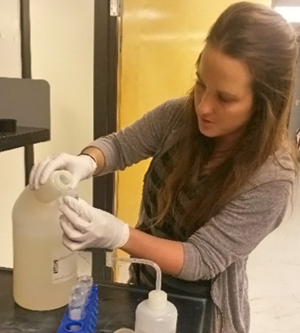
Ceil extracts meiofauna for closer inspection. (Photo credit: Kesley Gibson)
Painstaking lab work followed, with each sample taking up to ten hours to process. Ceil sorted the samples using a centrifuge to separate the meiofauna from the sediments. Then she isolated animals and documented densities. She counted the meiofauna under a microscope, classifying them where she could and sending the others to experts to identify. The team has described entirely new species of meiofauna in a group known as mud dragons.
Ceil processed, analyzed, and reported on the resultant data sets. She and others on their team have been writing manuscripts about their findings, including one paper on which she was the lead author: International Journal of Oceanography Sediment chemistry and meiofauna from the Northern Gulf of Mexico continental shelf.
Her Learning
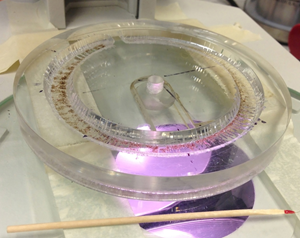
Ceil uses a counting wheel under a microscope to count and sort the meiofauna. (Photo credit: Ceil Martinec)
Ceil credits Landers for his guidance through the world of research science.
“I have learned that although the scientific process can be tedious at times, it is very rewarding,” she said, adding that “constructive criticism from the people around you and the peer review process is very important in order to make your work better.”
Ceil presented her research at Gulf of Mexico Oil Spill and Ecosystem Science conferences in Mobile and Houston. Her presentation in Houston was about the marine nematode communities they collected from central Louisiana to Apalachicola, Florida at 49-316 meters depth. “It was exciting to join the larger GoMRI community,” she said. “Those experiences showed me the importance of networking and collaboration among fellow scientists.”
Her Future
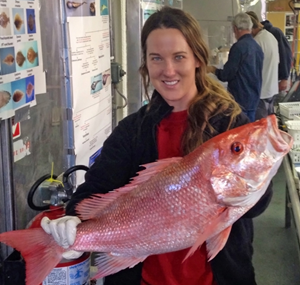
Ceil joined the annual NOAA Fish Survey cruise, identifying species like this red snapper. (Photo courtesy of Ceil Martinec)
Ceil graduated with her masters in May and married in September. She hopes to pursue a career in fisheries biology, ideally with the Alabama Marine Resources Division, focusing on either recreational or commercial fisheries. She also is considering fishery biologist positions with the State of Florida Fish and Wildlife Service and NOAA and environmental science openings in government, industry, or environmental consulting agencies.
Ceil plans to volunteer until the right position comes available. “Right now,” she said, “any experience I can get will be helpful in building my future career.”
Praise for Ceil
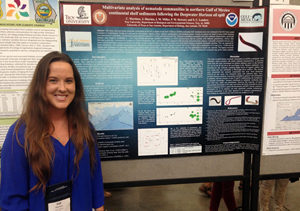
Ceil presents her findings at the Gulf of Mexico Oil Spill and Ecosystem Science conference in Houston. (Photo credit: Jonathan Miller)
Landers described Ceil as an excellent student, saying, “She tackled multivariate statistics and impressed me with how fast she absorbed its complexities.”
Ceil did not engage in lengthy field work as an undergraduate, but Landers felt that she was the right fit for the graduate-level position in his GoMRI project, and she did not disappoint him. “She worked very hard and was very involved in sample collections on the NOAA ships as well as in the lab,” Landers recalled. “She leaves Troy with one paper already published and another one in the works,” Landers said. “I’m sure she’ll be a very successful scientist.”
Ceil received the Troy University 2015 Best Graduate Research Scholar Award.
The GoMRI community embraces bright and dedicated students like Ceil Martinec and their important contributions. The GoMRI Scholars Program recognizes graduate students whose work focuses on GoMRI-funded projects and builds community for the next generation of ocean science professionals.
Learn more about this research at Landers’ website.
This research was made possible in part by a grant from BP/The Gulf of Mexico Research Initiative (GoMRI) to Troy University for the project Analysis of Continental Shelf Meiofauna in the Northern Gulf of Mexico: Effects of the Deepwater Horizon Oil Spill Investigated during a Long Term Community Study.
The GoMRI is a 10-year independent research program established to study the effect, and the potential associated impact, of hydrocarbon releases on the environment and public health, as well as to develop improved spill mitigation, oil detection, characterization and remediation technologies. An independent and academic 20-member Research Board makes the funding and research direction decisions to ensure the intellectual quality, effectiveness and academic independence of the GoMRI research. All research data, findings and publications will be made publicly available. The program was established through a $500 million financial commitment from BP. For more information, visit http://gulfresearchinitiative.org/.

Alek stands next to a map of his research area, holding the drift cards he used in his oil spill study in front of a nautical chart of the Salish Sea. (Provided by Alek)
Fueled by a passion for science and endangered species, Alek designed and executed a research project that involved scientists from eight institutions, four-hundred drift cards, and over a year’s work. A substantial undertaking for any scientist, this is even more impressive because Alek is seven years old.
Alek Finds a Calling
Alek lives in Washington near the coast where he has spent much time watching and learning about orca whales, specifically the Southern Resident Killer Whale of which there are about eighty known remaining.
“I really like the white eye patches they have,” he said. Scientists at the Center for Whale Research near Alek’s home are working hard to track and protect these orcas. “Dr. Ken Balcomb is the main whale researcher there,” said Alek. “He inspires me because he stands up for these whales’ freedom and protection.”

A copy of the first two pages of Alek’s hand-written letters asking for donations to fund his research in the form of an “Adopt a Drift Card” campaign. (Provided by Alek)
When Alek was five, he read a book that discussed the environmental impacts of the Deepwater Horizon and Exxon Valdez oil spills, which drove his desire to help protect the ocean ecosystem near his home. “My heart broke because it was so sad,” he recalled. “The whole ocean ecosystem was contaminated for hundreds of miles, and lots of ocean animals died.” Every year, thousands of oil tankers cross the Salish Sea, an intricate network of coastal waterways near the United States-Canadian border where many of these whales live. Alek became concerned that the Southern Resident Killer Whales could encounter and be affected by large amounts of oil if a spill occurred.
A Little Help From His Friends
Alek began gathering books on oil spills and visiting university research websites when he was six, focusing on oceanography departments that study spills.

A hand-drawn map that Alek included in his fundraising letter shows oil tanker routes in the Salish Sea. (Provided by Alek)
He emailed scientists around the country, including Piers Chapman and Tamay Özgökmen – the directors of the GISR and CARTHE consortia, respectively – for input on how to proceed. More than ten prominent researchers agreed to sit on Alek’s science committee and advise his research.
Alek chose to conduct a drift card study after finding out it would take more than a year to obtain a permit to deploy GPS-enabled drifters, an ocean current tracking method that he wanted to pursue like Özgökmen has done. Drift cards, made of wood or other lightweight materials that float on the water’s surface, are another tool that can show how currents move through an area. Chapman has used drift cards, deploying them at a fixed location and plotting times and points on a map where people report cards they discover (the cards have printed explanations about their purpose and reporting instructions). As Alek’s project developed, Chapman and Özgökmen answered his questions and reviewed his reports.
“Alek is an incredibly motivated young man,” said Chapman. “I was very happy to suggest possible ways that he could analyze his data while putting his report together and make suggestions to help give the video he made about his research more impact. He’s a great kid and deserves every encouragement.”

Alek paints his drift cards bright yellow using a non-toxic, biodegradable paint mixture. (Provided by Alek)
Alek’s family was supportive and helped him with the things he couldn’t do himself, such as traveling to various sites and using an electric saw to cut wood into drift cards. However, they encouraged Alek to raise the money needed for the project himself so that he would get a broader experience of being a scientist.
Alek sent letters asking people to sponsor a drift card for one dollar per card. He collected $460 from donors across the country, including many scientists, and even received a letter from President Obama thanking him for his work. He used this money to purchase biodegradable and nontoxic materials to build the cards.
If You Build Them, They Will Drift

Alek releases his finished cards in Rosario Strait between Peapod Rocks and Buckeye Shoals—one of the busiest oil tanker routes in the Salish Sea. (Provided by Alek)
Alek made two batches of 200 cards, each batch labeled either “A” or “B.” He deployed the cards at Rosario Strait, a dangerous channel that many ships pass through on their way south. He released the first set on September 6, 2014, as the tide was going out and the second set as the tide was coming in on September 21. Days and weeks went by, and one-by-one people in the area returned 181 drift cards. He even received information about one that had floated all the way to Alaska! He calculated the GPS coordinates where each card was found, logged them into a spreadsheet, and used this information to populate maps on Google Earth.

Some people who found drift cards sent Alek a photo of the card they found. Within four months, 45% of Alek’s drift cards had been found and reported. (Provided by Alek)
Alek then mapped the probable path oil would take through the Salish Sea should a spill occur in the Rosario Strait. He compared these paths to reports of orca migrations to show where their paths might encounter oil. “The orcas don’t know how to avoid oil in water, so they would swim right through it,” said Alek. “It is sad to find out that, if my oil spill simulations were real, every single one of the endangered orcas here would be at risk of oil contamination.”
When he completed his study, Alek created a website about the project. The site contains an overview of his work with maps, charts, and graphs showing his findings and suggestions for what the public and lawmakers can do to reduce our dependence on oil and protect endangered species. No one from congress has responded yet, but many others have, including Jane Goodall who sent an email praising his efforts to call attention to these whales’ potential risk. Alek also created a short video summarizing his study, a one hour video detailing his project, and a 154-page scientific report.

This person sent Alek a picture of himself and the drift card he found. (Provided by Alek)
“I was so impressed by Alek’s one-hour movie of his year-long study—the level of detail was amazing,” reflected Özgökmen. “We are looking at a hardworking, brilliant young mind here. I can only hope that he gets the best education this country can offer, as he will have much to contribute to our society in the future.”
Alek’s Perseverance
Alek admitted that creating the spreadsheets and maps was more work than he expected. After several months of data entry and analysis, there were times when he felt like giving up because of the work volume.

Alek proudly shows off his data spreadsheets. He has promised to share his data, analysis, and maps with other scientists and research groups to help support their environmental studies. (Provided by Alek)
However, he said that instead of quitting, he looked to the great scientists of history to remind himself to keep going, “I thought: What if they gave up? If Copernicus gave up, we might never know the sun was the center of the solar system. If Charles Darwin gave up, we might not know about evolution. If Crick and Watson gave up, we might not know how genetics and DNA work. I learned I couldn’t give up, because everything that is important in life takes hard work!”

This Google Earth map shows the differences in estimated contamination areas one week after oil is released under an outgoing tide (red) and an incoming tide (yellow). (Provided by Alek)
What’s next on Alek’s radar? He sees “endless possibilities” for more science in his future. “Some of the things I am thinking about are chemistry, building an underwater ROV, and 3D printing,” he said. He also stated that, although still many years in the future, he hopes to study marine science in college. One thing is certain: whatever direction he eventually pursues, Alek has already proved himself a precocious scientific thinker in the world of oil spill research.

This Google Earth map shows the estimated area at risk of oil contamination four months after the simulated spill. (Provided by Alek)
************
The Gulf of Mexico Research Initiative (GoMRI) is a 10-year independent research program established to study the effect, and the potential associated impact, of hydrocarbon releases on the environment and public health, as well as to develop improved spill mitigation, oil detection, characterization and remediation technologies. An independent and academic 20-member Research Board makes the funding and research direction decisions to ensure the intellectual quality, effectiveness and academic independence of the GoMRI research. All research data, findings and publications will be made publicly available. The program was established through a $500 million financial commitment from BP. For more information, visit http://gulfresearchinitiative.org/.
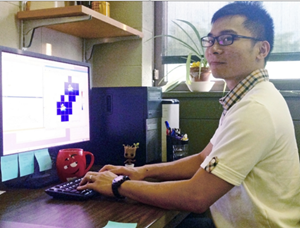
Bicheng at Pennsylvania State University works on the coding for simulations involving oil plumes. (Provided by Bicheng Chen)
Bicheng Chen is dedicated to seeking the physical explanations behind everyday phenomena. His research on ocean turbulence and numerical modeling led him to investigate the interactions among wind, waves, and turbulence and their effect on oil transport and dispersion.
Bicheng is a meteorology Ph.D. student at Pennsylvania State University and a GoMRI Scholar with the project Large Eddy Simulation of Turbulent Dispersion of Oil in the Ocean Surface Layers: Development, Testing and Applications of Subgrid-Scale Parameterizations. He discussed his research and reflected on his academic journey.
His Path
Bicheng’s childhood dream of becoming a scientist began by watching spacecraft on television and grew after his first middle school physics class. He explained his fascination, “Physics is one of the only ways we can describe the phenomena we observe in our world.” Bicheng completed a physics undergraduate degree at Peking University and joined their atmospheric physics masters’ program, where he developed an interest in fluid mechanics and numerical modeling.
After completing his master’s degree, Bicheng contacted Dr. Marcelo Chamecki, a Penn State University meteorology professor, hoping to join his team researching turbulence – the continuous change in magnitude and direction of a fluid’s flow. Chamecki, working with Johns Hopkins University’s Charles Meneveau, had a research position available to track and predict oil dispersion in the ocean mixed layer. Bicheng happily joined Chamecki’s lab as a Ph.D. student, “Life in academia is very exciting,” he said. “My understanding of fluid dynamics and numerical modeling has been growing rapidly.”
His Work
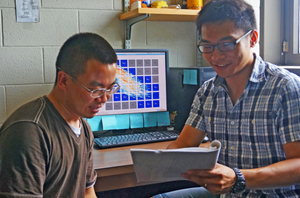
Bicheng (right) discusses his research with a colleague. A new technique that he is using to track oil plumes is visible on the monitor behind them. (Provided by Bicheng Chen)
Turbulence can cause vertical mixing of oil that forms a continuous plume, which helps disperse oil into the water column for microbial consumption. However, wind-wave interactions can also create Langmuir circulations, which are counter-rotating vortexes near the ocean surface that can affect the vertical mixing of oil. Langmuir circulations converge strong forces on the water’s surface and below that push small oil droplets into deeper waters and constrain large droplets at the surface.
Bicheng uses large-eddy simulations to examine oil plume evolution and the flow of the mixed ocean layer under varying wind speeds, wave characteristics, and oil droplet sizes. These simulations help him to visualize swell waves and see their effect on oil dispersion. “As this project evolves, I feel we are able to better understand the physical processes governing oil slick transportation and dilution in the ocean mixed layer,” he said. He hopes that his findings can help improve large-scale models used to predict oil transport and develop contingency plans.
His Learning
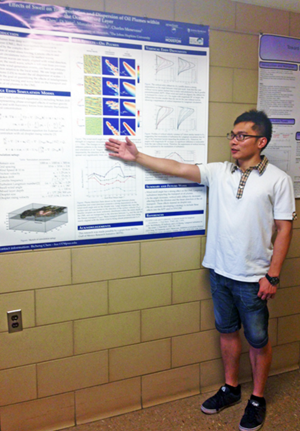
Bicheng displays a poster detailing his research at Pennsylvania State University. Bicheng and his advisor Dr. Marcelo Chamecki created this poster, which was presented at the 2015 Gulf of Mexico Oil Spill and Ecosystem Science Conference. (Provided by Bicheng Chen)
Bicheng is honored to conduct research alongside experts in his field. In addition to working with his advisor, Bicheng communicates frequently with Meneveau and Di Yang (University of Houston), “Our team members have a profound understanding of fluid mechanics, and our weekly teleconferences have contributed immensely to my learning experience.” He has enjoyed meeting with scientists in other disciplines at the annual Gulf of Mexico Oil Spill and Ecosystem Science Conference. He said it was exciting to see many different research fields brought together by the Deepwater Horizon oil spill. He added, “I especially enjoyed explaining my work to other scientists who are interested in addressing the same problem from a different perspective.”
Bicheng is thankful that his parents have always encouraged him to pursue his dream and supported his decisions, even when those took him far from his home in China. He explained that when his father was a young man, he had an opportunity to further his academic career but could not pursue it because his parents wanted him close to home. “When my time came, my father did not hold me back. Instead, he wanted me to go as far as I could,” says Bicheng.
His Future
Bicheng plans to pursue a post-doc position after he completes his Ph.D. and hopes to teach. He remarked that wherever his future takes him, he wants to continue learning new things and expand his knowledge of his field.
Praise for Bicheng
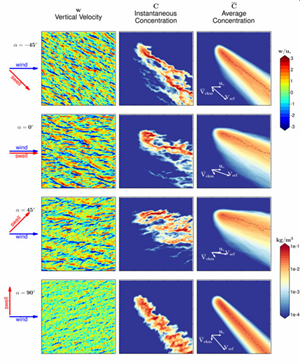
A figure from Bicheng’s poster. The figure depicts vertical velocity near the ocean surface (left column), instantaneous oil surface concentration (middle column), time-averaged oil surface concentration (right column), and the direction of wind stress and swell (arrows). It suggests that the angle between wind and swell has profound effects on the orientation and strength of Langmuir circulations (red/blue bands in left column), which causes different patterns in instantaneous surface plumes. (Provided by Bicheng Chen)
Meneveau, the project’s principle investigator, described Bicheng as a great asset. He praised his “can do” attitude and explained that his most impressive quality is his ability not only to conduct large simulations but also to extract insights and meaningful knowledge from them. “He showed results and then told us what they meant,” said Meneveau. “We were always able to have our discussions at a deep, conceptual level and concentrate on the physics rather than getting hung up on the technical details.”Chamecki said that Bicheng’s great personality and creative work have surpassed expectations, explaining that few graduate students can contribute to their project like he has. Chamecki recalled lamenting to Bicheng about the limitations of their numerical algorithm. “Bicheng had an idea to make the code run more quickly and it developed into an entirely new line of investigation that became an integral part of our project,” Chamecki explained. Looking back at Bicheng’s contributions, Chamecki believes that he has a successful science career ahead of him.
The GoMRI community embraces bright and dedicated students like Bicheng Chen and their important contributions. The GoMRI Scholars Program recognizes graduate students whose work focuses on GoMRI-funded projects and builds community for the next generation of ocean science professionals.
Learn more about this research on the Atmospheric Boundary Layer and Turbulence Research Group (Penn State) and Turbulence Research Group(Johns Hopkins) websites.
This research was made possible in part by a grant from BP/The Gulf of Mexico Research Initiative (GoMRI) to the Large Eddy Simulation of Turbulent Dispersion of Oil in the Ocean Surface Layers: Development, Testing and Applications of Subgrid-Scale Parameterizations. The GoMRI is a 10-year independent research program established to study the effect, and the potential associated impact, of hydrocarbon releases on the environment and public health, as well as to develop improved spill mitigation, oil detection, characterization and remediation technologies. An independent and academic 20-member Research Board makes the funding and research direction decisions to ensure the intellectual quality, effectiveness and academic independence of the GoMRI research. All research data, findings and publications will be made publicly available. The program was established through a $500 million financial commitment from BP. For more information, visit http://gulfresearchinitiative.org/.
Boryoung Shin is breaking new ground in microbiology, uncovering little known facts about an enigmatic and important species in the Gulf of Mexico.

Boryoung Shin works in an anaerobic chamber at the Kostka Lab at Georgia Tech. (Photo credit: Max Kolton)
After the Deepwater Horizon incident, certain bacteria rapidly increased and helped degrade the oil. These microbes, who consume naturally-occurring hydrocarbons, rise and fall in number as access to their preferred food supply changes. Boryoung’s research focuses on a subset of this group, the oil-eating bacteria that live deep within seafloor sediment.
A Ph.D. student in Earth and Atmospheric Sciences (EAS) at the Georgia Institute of Technology, Boryoung is a GoMRI scholar with the Deep-C consortium. She shares her journey from South Korea to the depths of the Gulf.
Her Path
When Boryoung was a high school student, she read a magazine article about deep ocean-dwelling creatures that changed her life. She became fixated on the idea of making deep sea ecology her future work. However, geography was a major hurdle as Boryoung had a difficult time locating courses that fit her needs. She explained that marine science programs can be hard to find in Korea: “It’s just not commonly studied.”
Boryoung’s persistence paid off, though, and she found an environmental marine science undergraduate program at the Hanyang University. Luckily, her next favorite subject was English. After obtaining a bachelor’s degree, she searched graduate programs at American universities to pursue her growing passion for microbial ecology. The work of Georgia Tech Professor Joel Kostka on the bacterial populations that consumed oil after the Deepwater Horizon spill impressed Boryoung. In 2012, she enrolled in the EAS Ph.D. program and, under Kostka’s direction, began research on sediment-dwelling microbes.
Her Work

The crew of the RV Weatherbird II collects sediment samples for Boryoung’s projects. Pictured from far left: Arvind Shantharam, Caroline Johansen, Ben LeBelle, Curtis Okolovitch, and Boryoung. (Photo credit: Ian MacDonald)
Oil-eating microbial communities that live in the water column and top layers of sediment need oxygen to survive. However, microbes that live deeper within Gulf sediments are anaerobic – they can live without oxygen.
Boryoung explained that oil can linger for a long time in sediment, an environment where there is little to no light or oxygen to assist degradation. The microbes she studies are one of the only means of breaking down oil once it has become buried in an anaerobic zone. To learn how these microbes operate, she cultivates Gulf sediment samples collected during a research cruise in June 2014 aboard the RV Weatherbird II. On that expedition, she collected sediment at over 1,000 meters depth for her lab work.
In the lab, she monitors these sediment-dwelling bacteria, a process that requires much patience. Anaerobic bacteria grow incredibly slowly – a year or more can pass before there is measurable activity in her cultures. Boryoung isolates these microbes, enriches them with various nutrients, and observes their community structure response. She analyzes their DNA to determine the succession of microbial groups that follows after oil exposure.
Boryoung laughs, “This process can take so long that I sometimes find myself asking, ‘What am I doing?’ I have to give myself pep talks that this is worth the wait, that it’s valuable science.”
Her results have been worth the wait. Many of these anaerobic microbial groups are not closely related to known hydrocarbon-degrading bacteria. As one of the first scientists to describe these populations, Boryoung has identified unique oil-degrading bacterial communities under sulfate- and iron-reducing conditions. Her long-term goal is to use her results to guide oil spill response efforts and uncover new potential methods for bioremediation.
Her Learning

Boryoung cultivates anaerobic bacteria populations in a Gulf of Mexico sediment sample housed at Georgia Tech. (Photo credit: Boryoung Shin)
Boryoung’s first research cruise was more difficult than she expected. She did not sleep well and was frustrated with very limited communications on board. But she really enjoyed working with the helpful and friendly crew and research team. Overcoming these obstacles made it that much more rewarding when she successfully completed her mission. Boryoung is greatly looking forward to using her newly-acquired sea skills on an expedition this August.
As much as she enjoys fieldwork, her favorite aspect of research is the science community she has joined. “The people I meet at GoMRI conferences really inspire me,” Boryoung said, referring to the annual Gulf of Mexico Oil Spill and Ecosystem Science conferences. She explained that the researchers she has met are very supportive of one another’s work. Calling it a synergistic relationship, she said, “We help each other, share ideas, and learn from one other.”
Her Future
As Boryoung continues her research with C-IMAGE, she is considering both academic and industry jobs once she completes her Ph.D. An aspect that draws her to academia is the concept of solving problems. She encourages other young people to choose science as a career so that more researchers can work together for the benefit of the Earth and people. She also hopes to continue living in the U.S.
“I want to be a ‘real’ scientist wherever I am,” Boryoung jokes. “Seriously, I like the culture here in the United States and this is where the work is for the most part. I hope I’m privileged enough to stay.”
Praise for Boryoung

Boryoung with her cohorts at the Kostka lab. From far left: Patrick Steck, Will Overholt, Xiaoxu Sun, John C. Gaby, Boryoung Shin, Kaitlin Esson, and Joel Kostka. (Photo courtesy of Deep-C)
Kostka describes Boryoung as a bright and dedicated young researcher, noting the tremendous amount of progress she has made in advancing anaerobic microbiology since she arrived at Georgia Tech. “She has the hardest job of any of my students,” said Kostka. He continued, “Hydrocarbon degrading bacteria grow very slowly under anaerobic conditions, and it usually takes Boryoung about one year to do a single experiment.” He said that Boryoung has isolated some cultures of anaerobic oil-degrading bacteria and is using molecular techniques to understand the processing of oil hydrocarbons in anaerobic sediments. Kostka also commented that aside from her academic capabilities, Boryoung is a pleasure to work with. “She nearly always has a smile on her face and a kind word for her colleagues. Her language skills are amazing, and she has embraced the American culture from the beginning of her tenure in Atlanta.” Kostka sees a bright future in science for Boryoung.
The GoMRI community embraces bright and dedicated students like Boryoung and their important contributions. The Scholars Program recognizes graduate students whose work focuses on GoMRI-funded projects and builds community for the next generation of ocean science professionals.
Visit the Deep-C website to learn more about their work.
************
This research was made possible in part by a grant from BP/The Gulf of Mexico Research Initiative (GoMRI) to theDeepsea to Coast Connectivity in the Eastern Gulf of Mexico (DEEP-C) consortium.
The GoMRI is a 10-year independent research program established to study the effect, and the potential associated impact, of hydrocarbon releases on the environment and public health, as well as to develop improved spill mitigation, oil detection, characterization and remediation technologies. An independent and academic 20-member Research Board makes the funding and research direction decisions to ensure the intellectual quality, effectiveness and academic independence of the GoMRI research. All research data, findings and publications will be made publicly available. The program was established through a $500 million financial commitment from BP. For more information, visit http://gulfresearchinitiative.org/.

Subham conducts an ethoxyresorufin-O-deethylase or EROD assay to measure the activity of the detoxifying enzyme CYP1A1 under PAH exposure. (Provided by Subham Dasgupta)
Subham Dasgupta’s dedication to understanding oil and dispersant toxicology stems from his roots in India. Having grown up in a community where fishes are an important part of the diet, his research assessing oil and dispersant exposure’s effect on fish health has a special importance for him.
“Oil spills can affect marine organisms, including the fish we eat,” he says. “This is particularly important for my country, which is surrounded on three sides by the sea. I hope that my research will help inform responders’ cleanup decisions and uncover new information about dispersed oil’s potential impacts on marine organisms.”
Subham is a marine sciences Ph.D. student at Stony Brook University and a GoMRI Scholar with the project Characterizing the Composition and Biogeochemical Behavior of Dispersants and Their Transformation Products in Gulf of Mexico Coastal Ecosystems. He shares his research and the important lessons he has learned from it.
His Path
As an undergraduate student at Presidency College (now University) in Kolkata, India, Subham was unsure of his direction. It was not until he began an environmental sciences master’s degree that he discovered his love for research. The many paths available to answer scientific questions and the possibility for collaboration across multiple disciplines excited him. His involvement with several research projects near Kolkata led him to pursue a Ph.D. in aquatic toxicology.
“I applied to programs in the United States because the education system and research quality are well-known,” Subham said. He connected with Dr. Anne McElroy, an aquatic toxicology professor with the Stony Brook University School of Marine and Atmospheric Sciences graduate program. His work in her lab initially focused on analyzing the impacts of oxygenated polycyclic aromatic hydrocarbon (PAH) exposure on the embryos of Japanese rice fish (also known as the medaka or Japanese killifish Oryzias latipes).
His Work
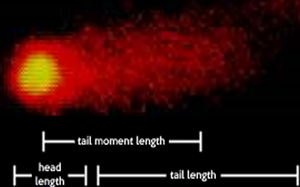
Subham’s comet assay technique measures DNA damage under different oil and dispersant component exposures. Results appear as “comets” such as this, where the “head” of the comet represents nucleoid with intact DNA and the “tail” represents damaged DNA that has migrated out due to electrophoresis. (Provided by Subham Dasgupta)
When McElroy joined a GoMRI-funded research group led by Mississippi State University’s Darrell Sparks, Subham’s research shifted to investigate the toxicity of Corexit 9500 and 9527 dispersants and their major components to sheepshead minnow (Cyprinodon variegatus) embryos and larvae. He evaluated Corexit-exposed larvae and examined the impact of low concentrations of the surfactant DOSS on larvae survival and possible correlation of DOSS and other solvents with DNA damage.
Subham is now investigating potential toxicity amplification in fish under hypoxic conditions combined with Corexit and oil exposure. “Hypoxia is an increasing concern in coastal areas with river discharge,” he said. “River waters carry nutrients from fertilizers that can trigger phytoplankton blooms. The increased microbial activity leads to reductions in dissolved oxygen in the water. The Northern Gulf of Mexico has an expanding area of seasonal hypoxia.” His studies with sheepshead minnow larvae are indicating that Corexit and water-soluble oil components may stimulate an increased production of CYP1A, an enzyme that assists the transformation of PAHs into less-toxic compounds that the fish can expel. However, hypoxic conditions may reduce CYP1A activity, potentially contributing to accumulation of oil and dispersant components in fishes and posing a greater risk to aquatic organisms.
His Learning
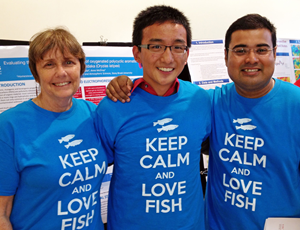
Subham (right) poses with Anne McElroy (left) and a high school summer research fellow, who enjoyed working with Subham and McElroy so much that he created matching t-shirts for the group. (Provided by Anne McElroy)
Studying numerous compounds contained in oil and dispersants, Subham has become more aware of different ways to approach an experiment and found that a study’s path is often unpredictable. “You can’t always look at it from the linear perspective that A will lead to B. A might lead to B, C, and D, and it’s exciting how that works out,” he says. Communicating with other researchers has exposed him to new scientific techniques and perspectives that have helped advance his research. “I had good success incorporating some methods I heard about at last year’s Gulf of Mexico Oil Spill and Ecosystem Science Conference into my work,” he said. “There are many ways to look at the same problem, and that is what I love.”
One of the most important lessons Subham has learned from his advisor is that scientific research requires patience. “I’ve never seen her frown or complain, and that showed me that I need to be patient with what I’m doing,” he explains. Experiments can fail as often as they succeed, and he believes that scientists should not view failures negatively. Instead, he focuses on brainstorming new ways to solve problems. “I think focusing on overcoming your failures teaches you something about life,” he says. “You can’t always expect the best – sometimes you have to deal with the worst to get the best.”
Subham’s journey has confirmed for him that students considering a career in science should pursue science because they want to, not because they think they should. “Like all fields, science is full of pluses and minuses, happiness and disappointment, success and failure,” he says. “It’s not as if you come into the field and immediately have success. It’s hard work.” Subham finds that as long as you love your field, the struggles will always be worth it.
His Future
After completing his Ph.D., Subham would like to serve in a post-doc position and continue in academia as a researcher and professor. Ultimately, he wants to return to India and help develop the marine science and toxicology field using his education and experience. “For a country surrounded by water and influenced by a large number of major rivers, the study of aquatic toxicology needs to be better developed. Given the opportunity, I would love to execute my training back in India – hopefully that will happen.”
Praise for Subham
Subham’s advisor, Dr. Anne McElroy, said that he is dedicated to his research and described him as extremely enthusiastic, unfailingly optimistic, and willing to do whatever is required to meet his research goals. “A comet assay technique that Subham adapted for use on sheepshead minnow larvae allowed us to detect direct DNA damage and demonstrate that oxygenated PAHs have similar if not greater genotoxicity than parent PAHs,” she says. McElroy is excited about his future as a scientist, explaining that Subham’s broad interests give her confidence that he will go far.
The GoMRI community embraces bright and dedicated students like Subham Dasgupta and their important contributions. The GoMRI Scholars Program recognizes graduate students whose work focuses on GoMRI-funded projects and builds community for the next generation of ocean science professionals.
Visit the Stony Brook University School of Marine and Atmospheric Science website to learn more about their work.
************
This research was made possible in part by a grant from BP/The Gulf of Mexico Research Initiative (GoMRI) to the project Characterizing the Composition and Biogeochemical Behavior of Dispersants and Their Transformation Products in Gulf of Mexico Coastal Ecosystems. The GoMRI is a 10-year independent research program established to study the effect, and the potential associated impact, of hydrocarbon releases on the environment and public health, as well as to develop improved spill mitigation, oil detection, characterization and remediation technologies. An independent and academic 20-member Research Board makes the funding and research direction decisions to ensure the intellectual quality, effectiveness and academic independence of the GoMRI research. All research data, findings and publications will be made publicly available. The program was established through a $500 million financial commitment from BP. For more information, visit http://gulfresearchinitiative.org/.
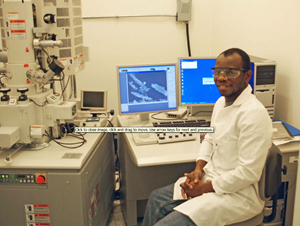
Sehinde, at the Tulane University Coordinated Instrumentation Facility, sits beside the scanning electron microscope he uses to image halloysite nanotubes and oil droplets stabilized by them. (Photo by Chike Ezeh)
An interest in oil spill research led Olasehinde Owoseni from Ile-Ife, an ancient city in Nigeria, to the Louisiana coast. Such a change might seem intimidating, but Sehinde sees it is as a small step toward his greater goal.
His research examines the use of miniscule clay particles for the development of safer and more cost-efficient oil spill remediation technologies.
Sehinde is a chemical and biomolecular engineering Ph.D. student at Tulane University and a GoMRI Scholar with C-MEDS. He explains his research and personal journey as a scientist.
His Path
Sehinde is proud to be a chemical engineer because he feels that transforming natural materials into useful products creates “a vital link between scientific understanding and societal application.” He completed an undergraduate degree at Obafemi Awolowo University – Ile-Ife and began his chemical engineering career at PZ Cussons, an international detergent and cosmetics manufacturer. Working in industry gave him a taste of practical engineering, but he had a deep desire to continue his education. While researching graduate schools, he heard about dispersant technology research at Tulane University led by Dr. Vijay John, director of C-MEDS. Sehinde was eager to take part in the search for more ecofriendly dispersant systems and enrolled in Tulane’s chemical and biomolecular engineering doctoral program. There, he joined the lab of his advisor Dr. John, whose research aims to design the next generation of dispersants.
His Work
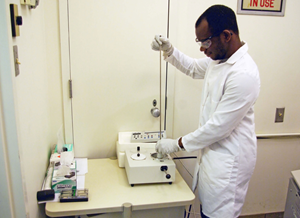
Sehinde uses liquid nitrogen to freeze oil droplets stabilized by halloysite nanotubes. Cryogenic imaging of these droplets will allow researchers to visualize the nanotubes and how they attach to the surface of oil dispersed in water. (Photo by Chike Ezeh)
Sehinde’s initial research focused on improving oil dispersants by replacing potentially harmful components with natural materials. Dispersants contain substances that lower surface tension (surfactants) and substances that disperse oil for microbial consumption (solvents). He considered these components’ roles and saw the potential to replace solvents used in existing dispersants with halloysite, a naturally occurring clay composed of tiny nanotubes. “Instead of using completely solid particles, we chose hollow particles that could be filled with surfactant,” he explains. “This is the first time the use of hollow particles has been applied to oil spill remediation.”
Sehinde loaded surfactant into the nanotubes using vacuum suction and then applied them to the surface where oil and water meet. He found that surfactant-loaded nanotubes were more effective at dispersing oil and keeping it dispersed than commercially-available dispersants. The nanotubes released surfactant slowly, creating smaller droplets that are easier for oil-degrading microbes to eat. The nanotubes also linked together across the oil’s surface, which prevented droplets from regrouping into a larger form. Sehinde’s halloysite research resulted in a Langmuir journal article and was featured on the GoMRI website, Study Finds Ecofriendly Clay Delivers and Improves Oil Spill Treating Agents.

Sehinde uses Tulane’s rotary evaporator to load surfactants into halloysite nanotubes through vacuum suction and solvent evaporation. (Photo by Regan Manayan)
The halloysite experiment’s success led Sehinde to consider other ways the clay nanotubes could be used for oil spill response. His current research examines how loading nanotubes with magnetic materials could track oil’s movement through the ocean. The concept is based on nuclear magnetic resonance, which is when atoms in a magnetic field absorb electromagnetic radiation and re-emit it at a specific frequency. Magnetic clay nanotubes applied at the boundary between oil and water may cause oil atoms to respond to a magnetic field differently than bulk ocean water, indicating oil presence. Sehinde is also curious if magnet-loaded nanotubes could be used to help skim surface oil and if loading nanotubes with nutrients could help microbes degrade oil more quickly. “Those are some directions we can go, but we are taking it one thing at a time,” he explains.
His Learning
Working with C-MEDS has shown Sehinde that collaborating and exchanging knowledge are often the driving forces behind scientific discovery. He has enjoyed the C-MEDS research community because it allows him to learn and contribute simultaneously. “I’ve learned a lot about how science moves forward,” he says. “While you learn from people, people also learn from you. You always have to look at new things and think in new ways. This experience taught me how to be a good scientist.” Looking back at what he has learned, his advice to others considering a science career is that “a constant appetite for learning and a passionate commitment to excellence are essential qualities for a scientist.”
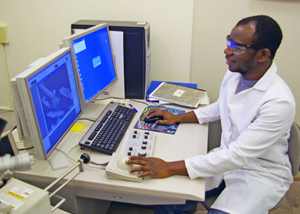
Sehinde conducts room temperature imaging of halloysite nanotubes with magnetic materials on the surface. (Photo by Chike Ezeh)
C-MEDS outreach activities have taught Sehinde how to better communicate with young people and stimulate their interest in science and engineering. He participated in middle school and high school outreach visits, explaining why oil spills occur and what might happen if they go untreated. He demonstrated how adding surfactant or particles can help break up oil in water so that the oil mixes with the water. “I did the experiment first,” he explained, “then, I let the students do it so they can see that it’s real – it’s science.” By stimulating student interest in oil spill treatments that incorporate natural materials, Sehinde believes his work to help reduce dispersants’ environmental impacts might gain public support. He had an opportunity to show high school students from a Louisiana fishing community how a single oil spill can have large impacts. This interaction was particularly memorable for Sehinde, “I enjoyed explaining the science and then relating it to their community. That form of outreach has been a really rewarding part of my work.”
His Future
Sehinde’s oil spill research has inspired him to apply his experience in a different field, improving the technology that powers our lives. In the future, he would like to conduct industry research on new and emerging energy systems, “I’d like to create ways to deliver power with minimal environmental impacts and explore alternatives to oil and gas.”
Praise for Sehinde
Dr. John identified determination as the force behind Sehinde’s abilities as a scientist. “He is a highly motivated student,” John said. “He is able to anticipate directions, driven by his own curiosity.” John explained that these characteristics have made Sehinde an important element of his lab, “He has been a joy to work with. The other graduate students in the department view him with much affection and respect. He is a role model for them, mentoring newer students and generating ideas with more senior students, some of which have led to collaborations with my faculty colleagues.”
Despite Sehinde’s strong personal drive, John describes him as being “quiet and scholarly” – someone who speaks through his work. “He thinks very creatively. Oftentimes, when we discuss research and ideas, he surprises me with subtle statements that indicate that he has not only thought of the idea but that he has also done the key experiment to validate his hypothesis,” John explained. “Sometimes, I wish Sehinde would argue a research point with me, but that is simply not his style. He listens, never pushes his opinion, and just quietly does his work. And, when it is done, it is clear that he has thought the problem through.”
John also praised Sehinde’s ability to communicate science effectively. He noted that Sehinde won 2nd place in the American Institute of Chemical Engineers Environmental Division Graduate Student Paper Award, which recognizes outstanding graduate student contributions to environmental protection through chemical engineering.
The GoMRI community embraces bright and dedicated students like Olasehinde Owoseni and their important contributions. The GoMRI Scholars Program recognizes graduate students whose work focuses on GoMRI-funded projects and builds community for the next generation of ocean science professionals.
Visit the C-MEDS website to learn more about their work.
************
This research was made possible in part by a grant from BP/The Gulf of Mexico Research Initiative (GoMRI) to theConsortium for the Molecular Engineering of Dispersant Systems (C-MEDS). The GoMRI is a 10-year independent research program established to study the effect, and the potential associated impact, of hydrocarbon releases on the environment and public health, as well as to develop improved spill mitigation, oil detection, characterization and remediation technologies. An independent and academic 20-member Research Board makes the funding and research direction decisions to ensure the intellectual quality, effectiveness and academic independence of the GoMRI research. All research data, findings and publications will be made publicly available. The program was established through a $500 million financial commitment from BP. For more information, visit http://gulfresearchinitiative.org/.
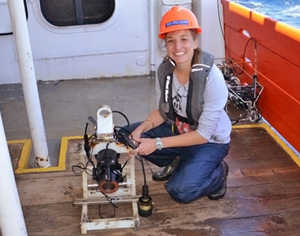
Caroline Johansen displays one of her camera systems that was lost for 9 months and found after three days of searching the seafloor. (Photo provided by Johansen and taken by a crew member of the R/V Pelican)
Caroline Johansen laughs when her family tells others that her research involves counting bubbles. But the bubbles she studies come from seeps at the bottom of the Gulf and contain naturally-occurring hydrocarbons that are an important part of the deep-sea ecosystem.
Caroline wants to shed light on how much oil enters the water every day through seafloor seeps in the Gulf of Mexico. Entire communities of deep-water bacteria as well as other organisms rely on these seeps for their survival.
Understanding the role of naturally-released hydrocarbons as part of a healthy marine environment can help scientists better gauge the impact of large hydrocarbon inputs such as from an oil spill. Caroline explained, “It is important for people to understand that the presence of oil in the ocean is not always a bad thing. It depends on the location, quantities, and time scales over which the oil enters the ocean. Understanding the amount released and the mechanisms involved can help us formulate a better understanding of the ecosystem.”
A Ph.D. oceanography student at Florida State University (FSU), Caroline is a GoMRI scholar working with ECOGIG. She talks about her research process and what she hopes to achieve.
Her Path
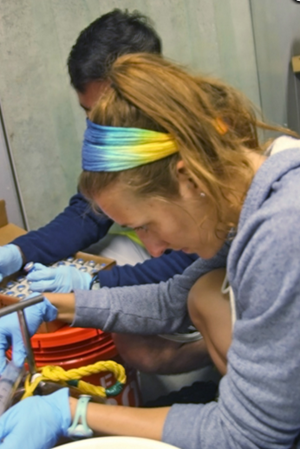
Caroline extracts gas from a “funnel beaker collector” that she designed and built to collect gas from natural seeps. (Photo credit: Ian MacDonald on the R/V Atlantis)
“I always asked a lot of questions and looked at the world with wonder,” Caroline said, explaining how she first became interested in oceanography. She grew up all over the world—living in seven different countries on four continents. Because her father worked in shipping, she realized at an early age that the ocean connected the planet like nothing else.
Caroline originally wanted to be a veterinarian, but a job at an animal clinic convinced her otherwise. After she completed her undergraduate degree in animal biology at the University of Florida, she took a short-term volunteer position as a research assistant for Katja Petersen Ph.D., affiliated with the University of Pretoria in South Africa. Working off the coast of Ganbaai, Caroline tracked the path of Southern Right Whales. She adored the open ocean field work and decided then to pursue a career in marine research.
While exploring graduate programs, Caroline discovered FSU’s Ian MacDonald’s work on oil seeps with the ECOGIG consortium. The concept of oil leaking into a marine environment as part of a natural process was completely new to her. She entered a master’s program in January 2012. Shortly afterwards with Dr. MacDonald’s encouragement, who was impressed by the quality of her research, Caroline moved into a doctoral program.
Her Work
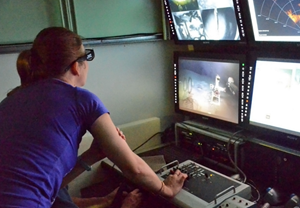
Caroline works with the ROV operator to position the camera in front of a hydrocarbon vent. (Photo credit: Dante DelGrosso, Oceaneering)
Caroline has developed new image processing methods to quantify the amount of oil coming through seeps. “I use underwater video cameras to look at natural seep sites. Then I process the video data to determine how much and how fast oil is naturally being released into the water column,” she explained. In other words, Caroline counts bubbles coming up from the seafloor.
This counting process is not as simple as she makes it sound. First, Caroline uses MacDonald’s satellite imagery of the Gulf to identify sites where oil may be seeping. Then she goes to the site on a research vessel equipped with a specially-modified video time-lapse camera (VTLC) mounted on a remotely operated vehicle (ROV). Caroline works with the ROV operator to carefully and accurately position the camera hundreds of feet below the water’s surface so she can video the oil rising. The length of time the camera deploys has varied in her seven trips—as short as three hours and as long as one month. Caroline must calculate the camera’s memory capacity in advance to know how often she can film during longer deployments—sometimes only seconds an hour.
Caroline processes the video data in the FSU lab. First, she isolates individual still frames from the streaming imagery. Then she uses a program to calculate an average size and distribution of the bubbles in each image. She measures and contours each bubble by hand, a process which can take more than a week. Finally, a computer program counts the bubbles by creating a line in the image and numbering each bubble as it crosses.
Caroline said that finding the location from which oil and gas come from and learning how it travels through the sediments can help us understand the complex dynamics of deep-sea seep systems. She wants to improve overall understanding about Gulf processes when they are working as intended, so that scientists will have a baseline if there is another large spill.
Her Learning
Caroline feels the biggest challenges—and, therefore, the biggest opportunities for learning—lies in fieldwork. She explained that conditions at sea can be challenging, but when she and her team accomplish their tasks, it feels like a victory. Field work with researchers in close proximity can spark great ideas, but circumstances have also forced her to solve problems on her own. “Sometimes you are faced with stressful or challenging situations, and you need to come up with a solution,” she explained. “You learn a lot about yourself.” Long hours of lab analysis follow the shipboard excitement. This exercise in patience provides its own reward in the form of usable data.
Caroline’s biggest pleasure comes from sharing what she has learned, particularly during education and outreach activities. She said that working with ECOGIG has taught her to communicate and work with various types of personalities. Being a member of the ECOGIG team and attending GoMRI meetings with like-minded learners makes her feel like she is participating in something larger than her focused work. She explained, “Unlike other events, the GOMRI conferences have a sense of familiarity and community.”
Her Future
Caroline hopes to finish her Ph.D. by the spring of 2016. She is considering a range of options from continuing in academia to entering industry. Regardless of which path she takes, she feels that communicating science to the general public is of the utmost importance. Helping people understand how seemingly small scientific findings, like those that come from counting bubbles, relate to a bigger-picture understanding of Gulf ecosystem health is one way to accomplish that.
“I am open to applying the skills I have gained to a wide range of positions involved with the deep sea. Regardless of where I continue my career, I would like to stay involved in both education and outreach,” she said.
Praise for Caroline
Ian MacDonald said of “Caro,” the nickname her friends and shipmates have given her, “What I really appreciate about Caro is her cheerful ability of rising to challenges. It doesn’t matter if she is handling heavy gear in rough seas, teaching a 6th grade class, addressing an audience of seasoned scientists, or learning a new programming language, she goes all-in and does it with a smile.”
MacDonald explained that her observations link to the larger picture of hydrocarbon migration, saying, “Her video clips reveal a beautiful and startling ‘microscape’ of oil, gas and gas hydrate, and an enormous numbers of ice worms.”
Calling her research “original and transformative,” ECOGIG science lead Samantha Joye said that Caroline is an ideal representative for the GoMRI Scholars Program. “Caro is a bright, talented, and hard-working young scientist,” said Joye. “She is exceptionally willing to support the efforts of others, whether through intellectual input or staying up half the night to help someone get their samples processed.” She added, “I could not be more proud to include her as part of the ECOGIG team.”
The GoMRI community embraces bright and dedicated students like Caroline Johansen and their important contributions. The GoMRI Scholars Program recognizes graduate students whose work focuses on GoMRI-funded projects and builds community for the next generation of ocean science professionals.
Visit the ECOGIG website to learn more about their work.
************
This research was made possible in part by a grant from BP/The Gulf of Mexico Research Initiative (GoMRI) to theEcosystem Impacts of Oil and Gas Inputs to the Gulf (ECOGIG) consortium.
The GoMRI is a 10-year independent research program established to study the effect, and the potential associated impact, of hydrocarbon releases on the environment and public health, as well as to develop improved spill mitigation, oil detection, characterization and remediation technologies. An independent and academic 20-member Research Board makes the funding and research direction decisions to ensure the intellectual quality, effectiveness and academic independence of the GoMRI research. All research data, findings and publications will be made publicly available. The program was established through a $500 million financial commitment from BP. For more information, visit http://gulfresearchinitiative.org/.
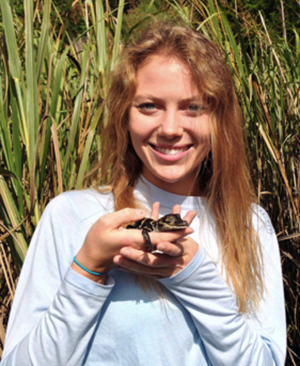
Lexi poses with a baby alligator during an alligator release trip. Other graduate students Lexi works with treat alligator eggs with mixtures of oil, Corexit, and other environmental contaminants to assess their effects on development. Lexi enjoys taking a break from the lab to help on release and egg collection trips. (Provided by: Lexi Temkin)
Unhealthy diet and inactivity are the first things that people think about that cause obesity.
However, Alexis Temkin is finding an unexpected potential contributor to increased fat cell production: a component in dispersants used for oil spill cleanup and many personal care products. She is excited to share her stories about the scientific detective work that is unfolding right now.
Lexi’s research melds medicine and marine science to help researchers and doctors better understand the impacts of oil spill compounds on the determination of human cell type. She hopes to influence the way chemical safety is approached, “Our group wants to improve testing for sublethal effects, such as fat cell production rates, when assessing certain chemicals. It’s a different way to think about safety and health.”
Lexi is a marine biomedicine and environmental sciences Ph.D. student at the Medical University of South Carolina and a GoMRI Scholar with the project Using Embryonic Stem Cell Fate to Determine Potential Adverse Effects of Petroleum/Dispersant Exposure. She shares her scientific journey and the places it could take her.
Her Path
Lexi’s story begins as a child who always enjoyed learning about the natural world. She describes herself as “that kid on the beach who would pick up all the bugs and fish” and gravitated toward science classes, particularly marine science and human health. Her varied interests made it challenging to answer every high school student’s least favorite question: what do I want to be when I grow up? While Lexi’s first instinct was to become a doctor, she could not shake her interest in marine science. She found ways to study both subjects as an undergraduate at Connecticut College. The more courses she took, the more she realized her true calling. “I genuinely liked medicine, but I became more interested conducting research than treating patients,” she says. “I think ‘be a doctor’ was an easier answer when I was a teenager than ‘be a research scientist’ because at that age you don’t really think of research as a career.”
While studying abroad at James Cook University in Australia, Lexi learned about marine biomedicine, which examines the potential of natural marine products to treat human diseases. It was the perfect marriage of her two major interests. She was able to get hands-on experience at the Harbor Branch Oceanographic Institute through Florida Atlantic University’s Summer Internship Program, researching how natural products isolated from bacteria in marine sponges could inhibit cell proteins associated with pancreatic cancer. Knowing this was the field for her, Lexi enrolled in the Medical University of South Carolina’s Marine Biomedicine and Environmental Sciences graduate program. There, she met Dr. Demetri Spyropoulos who had just begun GoMRI research on the molecular-level effects of oil and Corexit exposure on human health. “Since the grant had just started, we could ask a lot of different questions and watch the story unfold,” says Lexi. “It’s a very discovery-based science, and I love that.”
Her Work
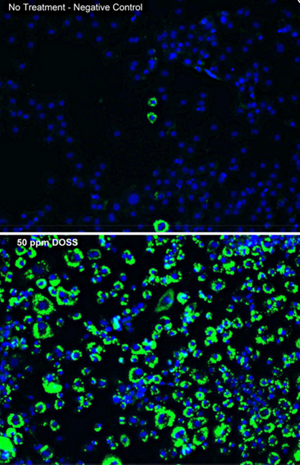
Images were taken from the fluorescent microscope Lexi used to measure the “fatness” of cells. She stained the cells with different colors of fluorescent dyes, which bound to the cell’s triglycerides or nuclei. Computer software linked to a fluorescent microscope counted the photons given off by the dyes to count cells and triglyceride levels. Here, cell nuclei are indicated by blue light and triglycerides are indicated by green light. These images depict cells with no exposure to oil or dispersant (above) and cells exposed to DOSS (below). (Provided by: Lexi Temkin)
Lexi’s study searches for compounds in crude oil, dispersed oil, and Corexit dispersant that can act as obesogens. Obesogens are chemicals that encourage stem cells to become fat cells by activating a receptor (fat cell differentiation). Previous and current research has shown that environmental exposure to certain chemicals (obesogens) can alter gene expression and cause fat cell differentiation. Lexi is using cell-based tools to ask if certain fractions of crude oil, dispersed oil, or dispersant contain obesogens.
Lexi refers to the detective part of her research as a “fishing expedition,” during which she devoted her energy to searching for possible obesogens among the many chemicals contained in oil and Corexit dispersant. One of her cell-based tools used bioluminescent transcription assays to help identify obesogen chemicals. She found that only cells in mixtures containing Corexit exhibited receptor activation. An assessment of the dispersant’s components narrowed her search to DOSS – a major component of Corexit formulations.
With this new information, Lexi used another cell-based tool to see how different DOSS concentrations drove fat cell production. She explained that you can actually see the cells increase in triglycerides and gain lipid droplets as they differentiate into fat cells. She measured the cell’s triglyceride levels and found that cells exposed to more DOSS were indeed “fatter” than those that had less or no DOSS exposure. Lexi and her team are collaborating with epidemiologists focused on human exposure to the Deepwater Horizonoil spill to identify biomarkers of DOSS exposure in human stem cells, humans, and mouse and alligator animal models.
Lexi is confident about the impact her research could have on preventative medicine. Information about the ways certain chemicals impact human health can help people make lifestyle choices that reduce their exposures and could even counteract negative effects. “Some people might see these findings as doom and gloom, but knowing the risks of exposures and how to avoid them should be empowering!”
Our partners at the Smithsonian Ocean Portal featured Lexi and her research in honor of Women’s History Month.
Her Learning
Lexi’s GoMRI experience has taught her the importance of being open-minded and communicating with other researchers. She encourages talking to people outside of one’s field, because they may offer a new perspective to your work. “I’d never worked with oil before, and we were unsure how to dose our cells,” says Lexi. “However, when we talked to people who work with oil and dispersants every day, they knew exactly which methods we should use and which mixtures to make.” Lexi emphasized the value of events like the Oil Spill and Ecosystem Science Conference. “GoMRI does an amazing job connecting different scientific communities and keeping everyone informed of what each other is doing,” she explains. Researchers from many different fields and backgrounds are brought together. It’s an incredible environment to work in, and I’m thankful for that.”
One of Lexi’s favorite memories is the moment she realized her research could improve not only our understanding of safer oil spill cleanup, but also medical practices. She and her team often collaborate with Reproduction, Endocrinology, and Childhood Health (REACH) – a research group studying environmental effects on children’s health. She presented a lecture explaining how embryos could develop a predisposition to obesity due to chemical exposure in the womb and detailing her DOSS research. A physician in the audience mentioned that doctors often prescribe laxatives containing DOSS to pregnant women, opening Lexi’s eyes to the potential scope of her research. “When we started our research, we didn’t know where this story was going to go,” reflects Lexi. “Human exposure to DOSS through an oil spill may generally be minimal, but if you’re a pregnant woman your exposure could come from many different sources. It was another moment when just talking to people could make this a completely different story.” Working with the REACH group, Lexi plans to compare fat levels and molecular markers in children whose mothers did and did not take these laxatives while pregnant.
Her Future
Lexi aims to complete her Ph.D. by the end of 2016. After graduation, she wants to get involved with education and community outreach opportunities in her field to help communicate knowledge about environmental exposures and their contributions to disease. “I think a lot of the science is out there, but people don’t know about it,” she says. Lexi is also interested in becoming a professor and teaching at the undergraduate level.
Reflecting on her journey, Lexi offered some advice for those considering a career in science. “It’s really easy to change fields, especially when you’re young. Trying different things is a good way to figure out what you want to do,” says Lexi. “Just because you do one type of research in college, it doesn’t mean that you’re locked into that one thing.” She encourages students who are curious about research to approach their professors and ask if they can get involved in on-going studies, “If you have even the slightest bit of interest in something, pursue it.”
Praise for Lexi
Lexi’s advisor, Demetri Spyropoulos, is enthusiastic about her potential as a scientist and researcher. He explained that Lexi stands out from other graduate students due to the innovation and exciting possibilities behind her project. “A mixture of sea water, Corexit, and Gulf oil is an incredibly complex mixture of components,” he explained. “It’s quite astounding that Lexi could determine that there was a potential ‘obesogen’ in the mix and be able to zero in on a single component.” He also noted that Lexi’s DOSS research has and will benefit greatly from her people-person skills, “We use some very sophisticated equipment and technologies, and Lexi is just as at home in these settings as she is when she’s getting news reporters and students excited about her project’s potential.”
Spyropoulos is proud to note that Lexi has not only done some great research, but also “brought it to a point at which they can ask some tough questions of safety: whether there are lasting impacts of exposure and, if so, what doses/exposures cause these impacts.” He explained that she can look for persistent DOSS-specific changes that identify people who have been exposed, the extent of their exposure, and impacts on their health. “She really wants to make a positive mark in this world and help the life in it,” he said. “And she’s running on all cylinders to make that happen.”
The GoMRI community embraces bright and dedicated students like Lexi Temkin and their important contributions. TheGoMRI Scholars Program recognizes graduate students whose work focuses on GoMRI-funded projects and builds community for the next generation of ocean science professionals.
Visit the department website to learn more about their work.
************
This research was made possible in part by a grant from BP/The Gulf of Mexico Research Initiative (GoMRI) to the Using Embryonic Stem Cell Fate to Determine Potential Adverse Effects of Petroleum/Dispersant Exposure. The GoMRI is a 10-year independent research program established to study the effect, and the potential associated impact, of hydrocarbon releases on the environment and public health, as well as to develop improved spill mitigation, oil detection, characterization and remediation technologies. An independent and academic 20-member Research Board makes the funding and research direction decisions to ensure the intellectual quality, effectiveness and academic independence of the GoMRI research. All research data, findings and publications will be made publicly available. The program was established through a $500 million financial commitment from BP. For more information, visit http://gulfresearchinitiative.org/.
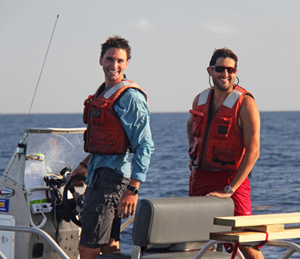
Conor (left) and University of Miami marine specialist Mark Graham (right) prepare to deploy a CTD to measure salinity and temperature profiles near the Deepwater Horizon site. Data from these measurements provide insight into the movement of the ocean surface. (Photo credit: Nathan Laxague)
After the Deepwater Horizon oil spill, many Gulf residents wanted to know where the oil was going and how fast it would get there. Conor Smith is improving the accuracy and turn-around time of satellite-derived surface current velocity estimates for better ocean transport information.
Conor is working toward a method that accurately interprets these velocities using information contained solely within synthetic aperture radar (SAR) satellite imagery. Currently, he combines ocean drifter data and a numerical model to account for wave motion with SAR data to estimate current velocity. His goal is that SAR-based speed estimates will be accurate enough so that there is no need for labor-intensive drifter data and developing and validating a near-shore numerical model. Conor says that doing so “will be useful to oil spill mitigation, as it will provide a rapid assessment of the surface current movements that transport pollutants.”
Conor is an applied marine physics Ph.D. student at the University of Miami (UM) Rosenstiel School of Marine & Atmospheric Science and a GoMRI Scholar with CARTHE. He shares the personal influences and intellectual experiences of a life lived on the water.
His Path
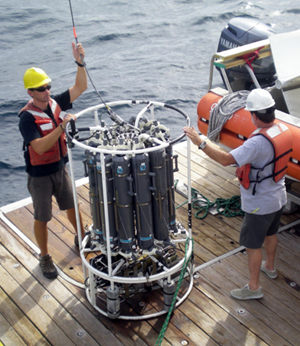
Conor (left) and University of Miami marine specialist Mark Graham (right) prepare to deploy a CTD to measure salinity and temperature profiles near the Deepwater Horizon site. Data from these measurements provide insight into the movement of the ocean surface. (Photo credit: Nathan Laxague)
Conor grew up near Chicago, where sailing on Lake Michigan with his family kept him close to the water. Before entering high school, his world changed in a big way. Conor’s parents homeschooled him and his brother for a year while the family sailed the Great Lakes and waters in Canada, the east coast, and the Bahamas. On that trip, Conor experienced wind-sea interactions first-hand while transiting locks, lakes, rivers, bays, channels, and island passes. He says that those experiences made him “fall in love” with marine sciences.
While completing his undergraduate physics degree at the College of Charleston in South Carolina, Conor toured UM. There, he met one of his future advisors, Ad Reniers, an associate professor of applied marine physics and lead investigator ofCARTHE’s SCOPE expedition. Conor was accepted to the UM Rosenstiel School graduate program working under Reniers and SAR-specialist professor Roland Romeiser. Conor credits his family’s support, a childhood near the water, hard work, and good luck with fueling his journey into oil spill research.
His Work
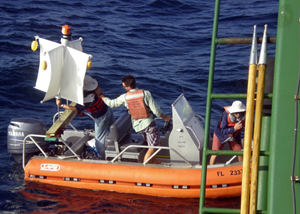
Aboard the Ibis, Conor (center) and fellow students Nathan Laxague (left) and Matt Gough (right) prepare CODE-style drifters to be released at a specific location. (Photo credit: Bruce Lipphardt)
Understanding how the ocean moves under an oil-covered surface is important to predicting where oil will travel. Conor tracks the speed of ocean surface currents using TerraSAR-X, an Earth observation satellite, which he says is similar to police radar guns. Police radar calculates car speed by emitting an electronic pulse that bounces off of the vehicle and returns to the instrument. “The satellite I work with uses the same principals to measure the line-of-sight speed of the ocean surface,” he explains. However, the circular motion of surface waves complicates current velocity calculations. To account for this motion, he checks the satellite’s speed estimates against drifter data paired with the Delft3D numerical model.
Conor conducts most of his research using conditions at the mouth of the Columbia River on the west coast. His calculations must be accurate and efficient under different circumstances, and this river inlet provides a dynamic range of ocean-surface water conditions that is perfect for comprehensive methods tests. Conor plans additional testing near Destin, Florida.
Conor has gained extensive experience with ocean surface drifters through his active involvement in two CARTHE experiments, the Grand Lagrangian Deployment (GLAD) and the Surfzone Coastal Oil Pathways Experiment (SCOPE). In these experiments, scientists released GPS-enabled drifters into the Gulf, collecting surface flow information that enhanced ocean current models and advanced our fundamental understanding of the ocean. Conor also applied his work to a real emergency response, the July 2013Hercules gas blowout. In three days, he and fellow CARTHE Ph.D. studentNathan Laxague formed an emergency drifter deployment plan, prepared the drifters, traveled from Miami to Louisiana, and launched drifters near the blowout site. “Had there been a contaminant of some sort released, our drifters would have provided one-of-a-kind data to predict the transport of it in the ocean,” said Conor. He talks more about this event in this video.
His Learning
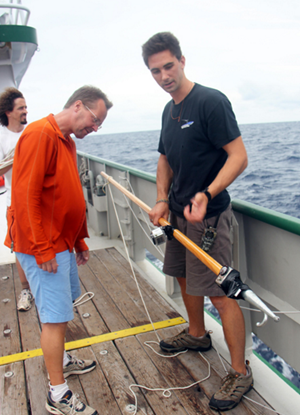
Conor (right) and Ad Reniers (left) inspect and prepare a camera rig to capture unique views of the first drifter deployment as fellow student Matt Gough looks on. (Photo credit: David Nadeau)” width=”300″ height=”415″> >Conor (right) and Ad Reniers (left) inspect and prepare a camera rig to capture unique views of the first drifter deployment as fellow student Matt Gough looks on. (Photo credit: David Nadeau)
One of Conor’s most memorable experiences was witnessing the collaborative efforts of many scientists during the GLAD experiment. Though he was initially overwhelmed by the experiment’s extensive preparations, which included building drifters, developing deployment and weather plans, and coordinating the ship’s assets and crew, he and the team worked together and successfully completed the tasks. “Working towards a common goal with a tight-knit group of people who were passionate for their research was inspiring,” he reflects. “It was both fun and thrilling to be part of a diverse team that required the coordination of so many assets. I felt appreciated for my own contributions to the group, and I learned how to better work as a team.”
Conor’s experience during the Hercules blowout response helped him see his research in a different light: “As the crippled and damaged Hercules rig came into view, I truly realized the importance of our mission and the efforts felt worthwhile.”
His Future
After completing his Ph.D., Conor wants to work in the development and deployment of ecofriendly power sources. He is particularly interested in hydroelectric turbines to be deployed in ocean currents or tidal waters. “Growing up on a sailboat taught me a lot about sustainable living. We lived comfortably using electrical power produced by a wind turbine mounted to our boat,” he explains.
Praise for Conor

Conor (far right), Mark Graham (right), and Texas A&M – Corpus Christi environmental scientist Derek Bogucki (left) lower an optical turbulence sensor overboard to sample micro variations in temperature near the ocean surface. (Photo credit: David Nadeau)
Dr. Reniers reflected on the unique skills and can-do attitude that have made Conor “a pleasure to work with and a real asset” to the team. “Conor is not your typical graduate student,” said Reniers. “He has exceptional field skills. You can tell him to take care of a drifter deployment somewhere in the Gulf of Mexico and he not only preps the instruments but also devises a plan for getting the vessel ready and conducting the deployment.” Reniers cited Conor’s quick and creative problem solving as one of his most important and distinctive traits, “Whenever some logistical obstacle prevents us from doing the experiment, he comes up with a quick and effective solution. He’s the MacGyver of the Seas.”
The GoMRI community embraces bright and dedicated students like Conor Smith and their important contributions. The GoMRI Scholars Program recognizes graduate students whose work focuses on GoMRI-funded projects and builds community for the next generation of ocean science professionals.
Visit the CARTHE website to learn more about their work.
************
This research was made possible in part by a grant from BP/The Gulf of Mexico Research Initiative (GoMRI) to the Consortium for Advanced Research on Transport of Hydrocarbon in the Environment (CARTHE). The GoMRI is a 10-year independent research program established to study the effect, and the potential associated impact, of hydrocarbon releases on the environment and public health, as well as to develop improved spill mitigation, oil detection, characterization and remediation technologies. An independent and academic 20-member Research Board makes the funding and research direction decisions to ensure the intellectual quality, effectiveness and academic independence of the GoMRI research. All research data, findings and publications will be made publicly available. The program was established through a $500 million financial commitment from BP. For more information, visit http://gulfresearchinitiative.org/.
 Funded by NOAA, the Ocean Sciences Curriculum Sequences are in-depth, kit-based curriculum units that deliver rich science content correlated to the Next Generation Science Standards (NGSS), with an emphasis on the Practices of Science as called for in NGSS and the Framework for Science Education K–12, and significant overlap with the Common Core State Standards for English Language Arts. The curriculum provides numerous opportunities for students to engage in investigations and make evidence-based explanations. They are designed in accordance with the latest research on learning and were classroom-tested by teachers across the United States in a wide variety of settings. Information about additional curriculum sequences can be found at http://www.lawrencehallofscience.org/gems/CurriculumSequences.htm.
Funded by NOAA, the Ocean Sciences Curriculum Sequences are in-depth, kit-based curriculum units that deliver rich science content correlated to the Next Generation Science Standards (NGSS), with an emphasis on the Practices of Science as called for in NGSS and the Framework for Science Education K–12, and significant overlap with the Common Core State Standards for English Language Arts. The curriculum provides numerous opportunities for students to engage in investigations and make evidence-based explanations. They are designed in accordance with the latest research on learning and were classroom-tested by teachers across the United States in a wide variety of settings. Information about additional curriculum sequences can be found at http://www.lawrencehallofscience.org/gems/CurriculumSequences.htm.
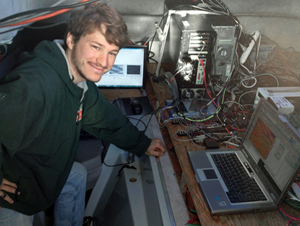
Nathan stands proudly in front of the data acquisitions system he set up inside the Surface Physics Experimental Catamaran (SPEC) during the 2013 Surfzone-Coastal Oil Pathways Experiment (SCOPE) in Destin, FL. (Photo credit: Tamay Özgökmen)
Nathan Laxague studies a small-scale subject matter that has potentially large-scale applications. Capillary waves – or ripples – on the ocean surface can indicate the presence of a film or oil slick on the water’s surface, making them “an important link in the chain of oil spill response.”
Nathan is a physics Ph.D. student at the University of Miami and a GoMRI Scholar with CARTHE. He describes how his involvement in collaborative interdisciplinary research has changed his perception of the scientific process and the way it is communicated.
His Path
Nathan has always loved both language and science, and his desire to “combine communication and science in a useful and empowering way” sparked his interest in research and teaching. His parents’ language arts backgrounds introduced him to eloquent communication, while his participation in Audubon camps near his seaside home of Scarborough, Maine, involved him in environmental sciences. When he entered college, Nathan chose a science major, feeling that would give him more professional fulfillment, and pursued language arts as a hobby. He completed a physics degree at the University of Miami and then set out to find his place in the scientific world.
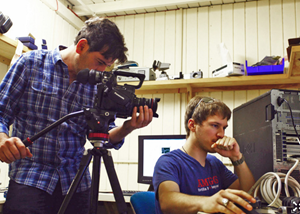
Nathan reviews salt-water tank images as producer Ali Habashi films footage for a CARTHE video detailing how field data and interconnected modeling can come together to improve our understanding of the surface currents that influence the fate of Gulf pollutants. (Photo credit: Tamay Özgökmen)
Nathan wanted something more tangible from his studies than laboratory work, so he focused on applied sciences graduate programs. After sending out emails exploring possibilities, Nathan was happy when the Division of Applied Marine Physics chairman Dr. Brian Haus requested a copy of his résumé. “If I had contacted Dr. Haus the year after or the year before, you’d be talking to someone else right now,” Nathan says, “It was definitely a case of right place, right time.” Dr. Haus had recently started a project with CARTHE investigating coastal surface currents to improve oil transport predictions, which Nathan thought was a perfect match for his physics background and fieldwork interest.
His Work
Nathan studies the interaction between the atmosphere and the ocean, specifically wind and waves. His focus is on using capillary waves, sometimes called ripples or cat’s paw ripples, to identify potential oil slicks. Satellites are very sensitive to the presence of short-scale surface waves. These waves’ absence leads to distinct dark regions in the satellite radar imagery, which can affect operational spill response. When these short-scale waves exhibit less energy than expected, then it is likely that something on the surface is preventing wave formation. Nathan explains how surface oil could do that, “If you blow on water in a greasy pan, it’s much tougher to get ripples than in a pan of clean water; the presence of oil knocks out these capillary waves.”
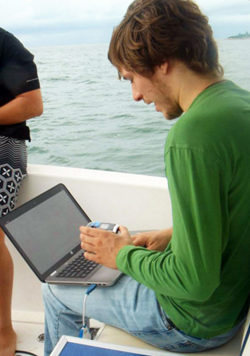
Nathan programs the Aquadopp acoustic current sensor for data collection during a drifter test in Biscayne Bay. The drifters being evaluated included those used in the GLAD and SCOPE experiments and an experimental design to be used in future research. (Photo credit: Tamay Özgökmen)
Because wind can easily interfere with satellite measurements of short-scale waves, Nathan’s research aims to enhance the remote sensing of these waves. However, collecting in situ data on mere ripples is not easy. Traditional sensors, such as gauges and lasers, are useful for measuring larger waves but disturb the surface too much to efficiently measure capillaries. Instead, Nathan uses a small camera that is able to sense short-scale wave slopes without distorting their structure. Because the application was new, Nathan’s first responsibility was making it work, “Dr. Haus pointed to the camera and said, ‘read this paper and learn how to replicate their method with that camera.’” Nathan was successful, and now he and his colleagues conduct fieldwork without disturbing the water’s surface, a process he describes as “a unique blend of in situ and remote sensing.”
Nathan’s participation in CARTHE’s first major field experiment, the Grand Lagrangian Deployment (GLAD), helped him understand how his work fit into a much larger scientific endeavor. GLAD used hundreds of drifters to track ocean surface currents around the Deepwater Horizon site. Nathan initially felt that collection of wave data was merely a “barnacle on the hull” of this history-making experiment, but he came to understand that all parts of their observational fieldwork were important to CARTHE research, “I felt like I was part of something enormous.” Nathan made a unique contribution using his language-arts skills to create an engaging, real-time narrative for the GLAD blog.
Nathan played a key part in CARTHE’s second major field experiment, the Surfzone Coastal Oil Pathways Experiment (SCOPE), that used drifters, dye, and drones to track and measure forces that move waterborne objects or contaminants onshore. Nathan planned and executed his own experiment – including wiring the research vessel’s cabin, setting up the instruments, and programming the computer for data collection – which afforded him a great deal of responsibility and autonomy for a graduate student.
His Learning
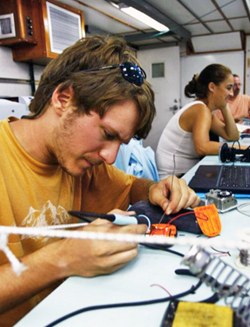
Nathan solders customized expanded battery packs into SPOT GPS units aboard R/V F.G. Walton Smith to compensate for the extended transmission time required by the GLAD experiment. (Photo credit: Tamay Özgökmen)
When bringing together experts from many different fields, one can expect some difficulty avoiding a “Tower of Babel” scenario. However, Nathan explains that CARTHE members “go with the flow – pun intended – and that turns into some wonderful research collaborations. For example, I’d sit down during breaks and, by just casually chatting with people about their research, I’d make more progress on my own work than I’d made in a month! I’ve had some of my greatest breakthroughs this way.”
Nathan has also made some keen observations about professor-student interactions. “To undergrads, professors act more like lawyers: they never ask a question they can’t answer. Once you become a graduate student, that changes. You’re both discovering the science together.” Nathan believes treating students as colleagues prepares them for future networking. “Engaging your students is the best way to get them to collaborate outside of your bubble,” he says. “Experienced scientists aren’t afraid to contact a professor they know across the country, but for a twenty-something it’s a big deal.”
Nathan also gained a new perspective on collaboration and scientists’ adaptability by observing the immediate multi-consortia response to the Hercules rig blowout. He and fellow grad student Conor Smith led CARTHE’s drifter deployment for the Hercules response. Initially, Nathan had associated research with months and even years of planning. However, seeing such rapid response changed that. “Fast response isn’t typical for a scientist,” explains Nathan. “We started planning on Tuesday afternoon and by Saturday morning we were out on the water collecting data. For a scientist, that’s pretty good!”
His Future
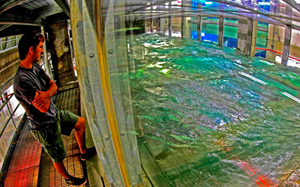
Nathan stands next to the new Surge-Structure-Atmosphere Interaction (SUSTAIN) wind-wave tank at the Rosenstiel School of Marine and Atmospheric Science (RSMAS). The enclosed acrylic tank (measuring 2m x 6m x 18m) has twelve independent wave paddles and a fan capable of delivering Category 5-equivalent wind speeds, making it the most complete wind-wave tank in the world. While the tank is still undergoing minor construction, Nathan says that it will play a key role in his future research. (Photo credit: Tamay Özgökmen)
Nathan is about half-way through his graduate work and wants to remain in academia either as a professor, his preference, or as a post-doc researcher. He would like to work in areas that combine disciplines, such as applied physics studying marine environments, and to “teach those who want to learn.”
Praise for Nathan
Dr. Haus describes Nathan as “an innovative and productive researcher.” Looking back on Nathan’s time with CARTHE, he says that watching Nathan collaborate and make connections with his fellow students has been an exciting experience. He also reflected on Nathan’s enthusiasm and creativity, saying, “I am often surprised by his ability to rapidly implement my suggestions and to take a small idea and grow it well beyond expectations. Nathan’s imaging work is opening up many avenues for fundamental air-sea interaction research.”
The GoMRI community embraces bright and dedicated students like Nathan Laxague and their important contributions. The GoMRI Scholars Program recognizes graduate students whose work focuses on GoMRI-funded projects and builds community for the next generation of ocean science professionals.
Visit the CARTHE website to learn more about their work.
This research was made possible in part by a grant from BP/The Gulf of Mexico Research Initiative (GoMRI) to theConsortium for Advanced Research on Transport of Hydrocarbon in the Environment (CARTHE). The GoMRI is a 10-year independent research program established to study the effect, and the potential associated impact, of hydrocarbon releases on the environment and public health, as well as to develop improved spill mitigation, oil detection, characterization and remediation technologies. An independent and academic 20-member Research Board makes the funding and research direction decisions to ensure the intellectual quality, effectiveness and academic independence of the GoMRI research. All research data, findings and publications will be made publicly available. The program was established through a $500 million financial commitment from BP. For more information, visit http://gulfresearchinitiative.org/.
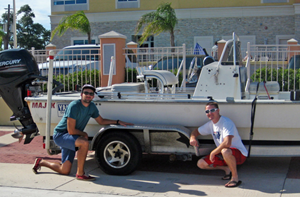
Dave Christiansen (left) and Garrett Kehoe (right) pose with their beloved but shambling boat trailer, which lost two of its four wheels during a data collection trip from Austin to Galveston Bay. (Photo credit: Matt Rayson)
David Christiansen is dedicated to investigating water movement and using those findings to improve local water systems.
He got his start monitoring Galveston Bay’s complex flow patterns as a precautionary oil spill measure. Dave’s hard work has taught him innovative problem-solving and has been applied to real-world oil spill response.
Dave was an Engineering master’s student at the University of Texas at Austin and a GoMRI scholar with GISR. Now a municipal water systems planner, he reflects on his graduate research challenges and the recent applications that made it all worthwhile.
His Path
In high school, Dave took as many math classes as possible, partly because he actually enjoyed them but also because his “mom wouldn’t have it any other way.” After starting college, Dave realized the Computer Graphics Technology program didn’t allow him to use his passion for math enough. Feeling that civil engineering was a better match, Dave switched his major after just one semester at Purdue.
There, he discovered an interest in hydrological engineering, which concerns the flow and transportation of water, and became a research intern under Dr. Cary Troy, who studies environmental fluid mechanics in the Great Lakes. Dave enjoyed the work so much that he began considering graduate research. “With input from Dr. Troy, I emailed professors at various universities about my interest and somewhat-limited experience in the field. My main goal was conducting fieldwork and collecting data.”
Dave received a response from environmental and water resources engineer Dr. Ben R. Hodges with the University of Texas at Austin, who believed Dave was perfect for his GISR research creating more accurate Gulf of Mexico oil transport models. A single visit convinced Dave that studying the circulation of Gulf Coast bays was for him. He moved to Austin in January 2012 and began his master’s research collecting water velocity data.
His Work
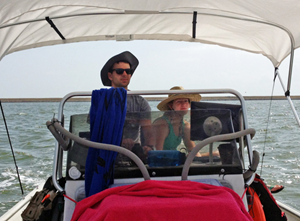
Dave Christiansen navigates as Abby Tomasek documents their course and passing ships in Galveston Bay. The choppy water forced them to take extra care waterproofing electronic equipment. The pink towel covers a homemade waterproof laptop case, vented by the tubes seen wrapping around the windshield. (Photo credit: Garrett Kehoe)
Understanding how water moves can help predict the path and speed of spilled oil. To track the circulation patterns of Galveston Bay, Dave measured water velocity using an acoustic Doppler current profiler (ADCP), which bounces sonar pulses off of suspended microscopic particles in the water column and uses the Doppler Effect – the change in a wave’s frequency based on the proximity of the wave source and the observer – to measure their velocity. The GISR team aimed to describe the flow of the entire Bay, a massive goal that Dave called “absolutely petrifying.” However, when reviewing the collected data, he noticed an interesting flow pattern near a dredge spoil island adjacent to the Houston Shipping Channel and made it the focus of his master’s thesis. “I spent as much time fixing our data-collection boat as I did collecting the data itself,” he jokes. “But, in the end, we collected great data that helped calibrate Stanford’s Galveston Bay oil spill model in anticipation of future spills.”
That “future spill” became a reality in March 2014, when a punctured oil barge released about 168,000 gallons of oil into Galveston Bay. This spill demonstrated to Dave how important research like his can be, “Oil spills negatively affect many people and wildlife. If we can decrease that damage by improving response, then we are doing a great service.” Dave’s work initially involved collecting data from multiple bays along the Texas and Louisiana Gulf Coast; however, a lack of resources forced the team to focus solely on Galveston Bay.
His Learning
Conducting fieldwork taught Dave that although difficulties can be frustrating, they also make completing the task that much more satisfying and have made him a quick-thinker. “Equipment malfunctions happen with fieldwork, and when you’re on a small boat mid-bay, there aren’t many tools at your disposal,” says Dave. “But, I think any engineer would say those situations are the most interesting. We all secretly, or not-so-secretly, want to be MacGyver and be able to resolve unexpected complications under stressful conditions without the proper tools.”
Being a member of the GISR research group has allowed Dave to learn from other scientists. At the 2013 Gulf of Mexico Oil Spill and Ecosystem Science Conference, Dave heard discussions between the world’s top oceanographic modeling and data collection researchers, “I heard a lot of new terms that I wrote down and Googled later. I simply became more aware of the research other people were doing, which was very enlightening.”
Dave’s experiences have made him appreciate the people in his life even more. “I’m thankful for my professors, Dr. Troy and Dr. Hodges, for introducing me to such an interesting field and for my wife and family, who have been so supportive throughout my learning experience. GoMRI and GISR mean a lot to me for funding my research.”
His Future
Dave has since graduated with a Master’s of Science in Engineering. He currently lives in Austin and works for Freese and Nichols, Inc., a 500-employee civil engineering consulting firm where he conducts master planning for municipalities’ water distribution and wastewater collection systems. Dave believes that the dwindling water supply in Texas is a problem that must be addressed with innovative engineering very soon, a problem he wants to help solve.
Praise for David
Dr. Hodges praises Dave’s dedication and persistence in the face of setbacks. Much of Dave’s time was spent gathering velocity via ADCP, a challenging yet essential task that often meant transecting the shipping channel for hours under some very tough conditions. Hodges said, “Dave was amazingly resilient and showed great ingenuity when things went wrong, persevering despite instrument failures and software glitches.” He also praised Dave’s “excellent” job conducting and teaching fieldwork. “It was great having a graduate student that I could just hand a field project to, say ‘go do it,’ and know it would get done.”
The GoMRI community embraces bright and dedicated students like David Christiansen and their important contributions. The GoMRI Scholars Program recognizes graduate students whose work focuses on GoMRI-funded projects and builds community for the next generation of ocean science professionals.
Visit the GISR website to learn more about their work.
************
This research was made possible in part by a grant from BP/The Gulf of Mexico Research Initiative (GoMRI) to the Gulf Integrated Spill Research Consortium (GISR). The GoMRI is a 10-year independent research program established to study the effect, and the potential associated impact, of hydrocarbon releases on the environment and public health, as well as to develop improved spill mitigation, oil detection, characterization and remediation technologies. An independent and academic 20-member Research Board makes the funding and research direction decisions to ensure the intellectual quality, effectiveness and academic independence of the GoMRI research. All research data, findings and publications will be made publicly available. The program was established through a $500 million financial commitment from BP. For more information, visit http://gulfresearchinitiative.org/.
The following material was compiled by the Office of Environmental Education (OEE) of the Florida Department of Environmental Protection for formal and non-formal educators. The list focuses primarily on resources relevant to educators and students (primarily K-12), but it is not a comprehensive list of resources. While care has been taken to review most of the material presented, teachers should use their best judgement and discretion in the selection of materials for use with their students (especially links leading off of the main pages identified below). The OEE would like to thank the educators from around the Gulf who contributed links and resources.

Major lakes and waterways in the Breton Sound estuary. Numbers refer to water testing locations along sampling route. Image: LSU
The Mississippi River Delta region, including the Breton Sound estuary along the southeastern coast of Louisiana, is both environmentally and economically important. The swamps, bogs and marshes of this region account for 40% of all the wetlands in the lower 48 states. Unfortunately,
these habitats were put in harm’s way when oil from the Macondo well began washing ashore. Scientists from Louisiana State University closely monitor water quality in the Breton Sound estuary and have expanded their efforts since the oil spill.
Classroom Activity: Water Quality on the Web
The internet is a valuable source for scientific data available to the public. In this lesson, students will access water quality information about Mobile Bay, a body of water that shares similar characteristics with Breton Sound. They will learn how to interpret the data provided and gain a better understanding of how water quality impacts a habitat.
Breton Sound Estuary_Water Quality – PDF 1.6MB
Middle and high school teachers in Florida put on their sea legs, boarded the R/V Weatherbird II, and conducted science that matters to their students and communities.

Dr. Teresa Greely (L) assists C-IMAGE Chief Scientist Leslie Schwierzke-Wade (middle) as she talks with 3rd graders at Jamerson Elementary in Florida during a Skype ship-to-shore video conference. (Also pictured is scientist Heather Broadbent). (Photo by: Mary St. Denis)
Educators worked with scientists to understand the impacts of the Deepwater Horizon oil spill. While gaining hands-on experience, teachers blogged and Skyped to share their learning and have others virtually join their adventures. Back on shore, teachers created classroom materials.
The Center for Integrated Modeling and Analysis of the Gulf Ecosystem (C-IMAGE) research consortium, led by the University of South Florida, hosts a Teacher at Sea Program. C-IMAGE expeditions collect marine data – from sea-surface plankton to deep-sea microbes in sediments – to answer questions about long-term oil spill impacts and understand the Gulf system.
This year’s participants were Matt MacGregor (Escambia High School), Mary St. Denis (Winter Haven High School), Elisabeth McCormack (Dunedin Highland Middle School), and Kathryn Bylsma (Dr. John Long Middle School). Their blogs depict life at sea and the academic rigor and challenges that go into planning and implementing sea experiments.
Below are a few highlights from their sea expeditions. Read more at the C-IMAGE blog Adventures at Sea: Deep Sea Fish and Sediment Surveys in the Gulf.
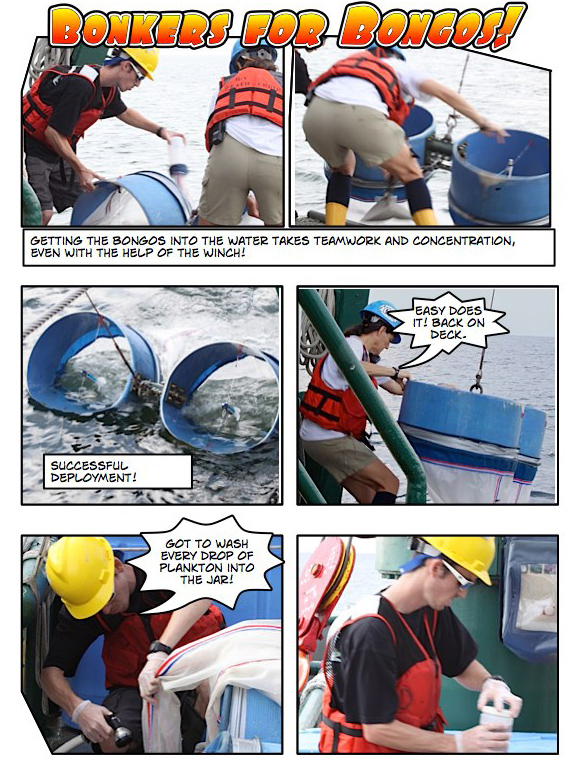
Teacher Elisabeth McCormack created a humorous way to share science with students. (Image provided by C-IMAGE)
Gung Ho! Enthusiastic Teachers
Teachers eagerly await their time at sea. Mary St. Denis said, “It is an exciting countdown to an adventure…to get out in the field and do science is a dream spot for many teachers like me.”
Some teachers expressed their enthusiasm through creative cartoon-style story-telling. Elizabeth McCormack created a skit filled with “characters” (real people on the vessel) and “action” (their at-sea research). Check out her Bonkers for Bongos blog !
Dr. Kendra Daly, the C-IMAGE chief scientist on the vessel was happy to have them: “The teachers were enthusiastic, hardworking, and valuable members of the science team.”
All Aboard! A Community of Active Learners
Impressive science teams are on board and their work of discovery and learning resonates with teachers, as Kathryn Blysma explains, “I am blessed to be surrounded by so many people who are avid learners… from such incredibly varied backgrounds… microbiology college students, European engineers, and graduate volunteers who enjoy…putting their skills to good use. It’s when there are interactionsbetween communities that true learning takes place.”
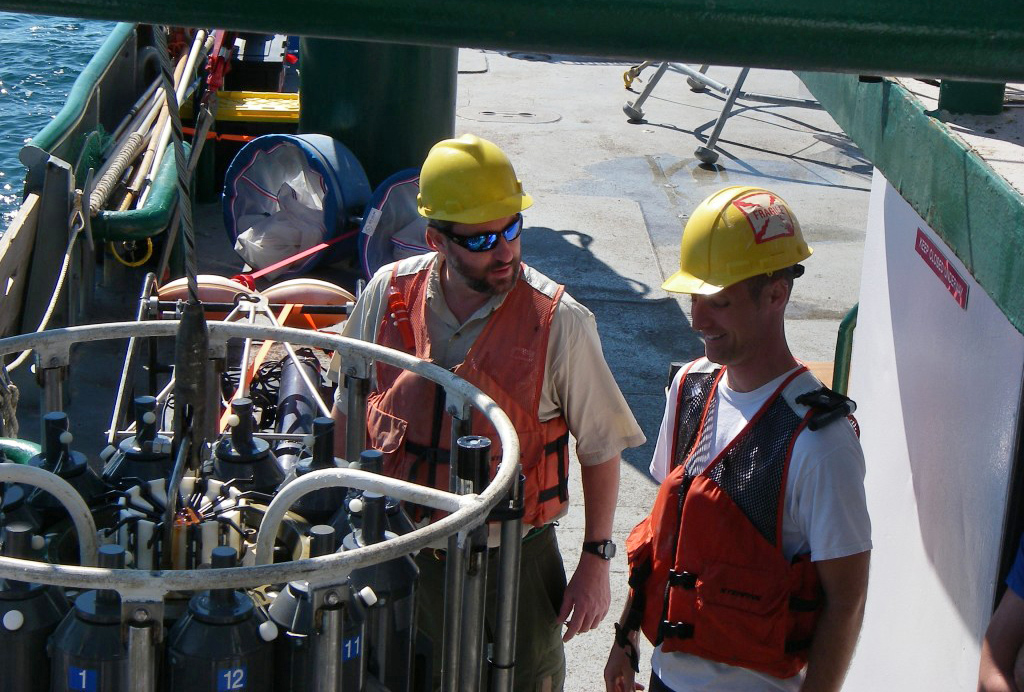
Teacher Matt MacGregor (R) and FWC scientist and graduate student, Matt Garrett prepare Niskin bottles in a CTD system. (Photo by: Teresa Greely)
That community spirit of learning and doing fosters teamwork. Blysma saw this as teams worked from early morning gathering data to late nights analyzing it: “This group has a real system down, a kind of bucket brigade where everyone takes a job or a section to be responsible for.”
Part of the learning involves sea technology. This year, C-IMAGE tested the SIPPER 4 (Shadow Image Profiler and Evaluation Recorder), a small “Rubik-cube size” underwater high resolution camera that goes deeper than earlier devices. It takes pictures of plankton and collects data on physical conditions. McCormack said the most exciting part was its internet connection ability, “That means engineers do not have to snag a spot on a research vessel to access the data, but can work with it in their lab thousands of miles away!”
College students are on board and they gave teachers insights on the value of hands-on learning. Blysma wrote about Joe, an undergraduate student, who had no interest in school until he went to an environmental center in his district. There, his whole outlook on learning changed. “[This] reminded me that each child we see is a ‘Joe’ searching for his niche. As teachers we are the wayfarers nudging and encouraging them at stages in that venture.”
All Hands on Deck! STEM in Action

Teacher Mary St. Denis (R) filters water with Dr. Teresa Greely (L) at the lab onboard the R/V Weatherbird II. St. Denis said, “My students and I are very concerned about the effects of the Gulf Oil Spill. I am really happy to be a part of finding out more about what is happening in the Gulf.” (Photo provided by C-IMAGE)
C-IMAGE conducts interdisciplinary science to understand Gulf marine ecosystems. McCormack described how science, engineering, and technology came together with the SIPPER 4, “A scientist may know what they want to measure, but it may take the mechanical mind of an engineer to build the device that can collect that data.” Marine technicians got the equipment in and out of the water, completing a demonstration of collaborative efforts among specialists.
Teachers experienced the evolving nature of science discovery when a routine task – collecting bottles of seawater – took on greater importance, becoming as McCormack said “one of the most important missions on this cruise.” They found one sample from deep Gulf waters that looked and smelled different and determined that it contained much less salt than water from that depth does normally.
They hypothesized about freshwater sources, including the Mississippi River outflow into the Gulf. Scientists will run additional tests at their home labs and look for an explanation. McCormack said, “I feel really lucky I was out here in the Gulf when we had a mystery to solve…I got a chance to see how all of this fits together.”
Field work reminded teachers that answering big questions requires a systematic process that takes time. McCormack said they could not start with “What happened to the Gulf after the oil spill?” explaining that “It is too broad, and impossible to answer with a single measure.” She likened it to eating a steak in one bite instead of pieces and explained that the scientific method includes collecting data many times and in multiple ways before tackling the difficult job of interpreting it. “But in the end,” said McCormack, “you have data that means something….You find answers to your questions and are inspired to ask new questions and start all over again.”
Ship-to-Shore! Connecting Future Scientists
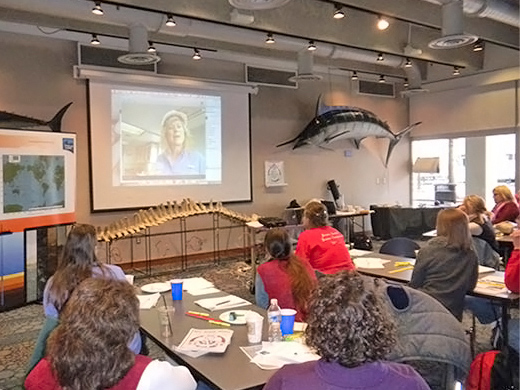
Dr. Teresa Greely (on screen) Skypes with educators during a professional development session at the New England Aquarium during IODP Expedition 340 in the Lesser Antilles. (Photo by: Jennifer Collins, Deep Earth Academy, COL)
C-IMAGE scientists use Skype to visually and verbally share their scientific missions in real-time with the K-12 community. One online demonstration was with 90 third graders at Jamerson Elementary School in St. Petersburg, Florida. They toured the boat, saw researchers retrieve bongo nets and collect plankton samples, and spoke with science experts and crew members. St. Denis marveled, “So far this week, about 370 students have virtually sailed with us.”
Teachers in the field make an impression on students, “Wow, Miss McCormack, you really have done a lot of stuff!” McCormack reflected on this important revelation, “My goal is to encourage students to both observe and interpret the world around them…to get out there and see real science happening.” She continued, “I love bringing authentic data sets to the math classroom so I can give students an answer to their ‘why do we need to learn this” questions.’”
Educators’ use of social media grabs students’ attention. One teacher described her class’ response to a Skype session: “They got a kick out of us using Skype!…It really hit home that it is a useful tool for ‘real’ work and not just socializing!”
Dr. Daly noted that the teachers “worked around the clock,” but “still found time to create blogs and communicate with their students. We were fortunate to have such wonderful volunteers.”
Bounty! Helping the Gulf
In the midst of all the bustling ship and research activities, teachers maintained a bigger-picture perspective. Reflecting on the “bottle of seawater” mystery, McCormack connected that specific experience with a larger purpose: “Scientists have systematically collected these samples over the past three years [and] have begun to create a historical database that will allow us to develop a clearer picture of how the Gulf behaves over time.”
Blysma wrote about the importance of connecting her experience with making future generations prepared to help the Gulf: “What does all this have to do with the Deepwater Horizon event or the data being collected? It’s the study of human impact on the environment and the critical balance that has to be maintained.”
For more information about the C-IMAGE Teacher at Sea Program, contact Dr. Teresa Greely. To learn more about the Florida Institute of Oceanography’s R/V Weatherbird II, take a virtual tour.
This research was made possible in part by a Grant from BP/The Gulf of Mexico Research Initiative (GoMRI) through theCenter for Integrated Modeling and Analysis of the Gulf Ecosystem (C-IMAGE) consortium. The GoMRI is a 10-year, $500 million independent research program established by an agreement between BP and the Gulf of Mexico Alliance to study the effects of the Deepwater Horizon incident and the potential associated impact of this and similar incidents on the environment and public health.
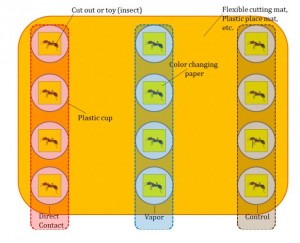
This experiment will test if the insects will die (i.e., the yellow color changing paper turning red once it comes in contact with a weak basic solution) once they have come in contact with crude oil through various exposure routes.
Many times, people think about the environmental impacts of an oil spill and the main organisms (impacted) that come to mind are marine mammals, crustaceans, fish, birds, and even mollusks. Insects are often forgotten, but some species are closely associated to soil and plant life; therefore, some insects are of high ecological value. Some insects live within the shoots of dead Spartina, directly exposed to marshes in which oil contamination has occurred. Researchers want to know what happens to some of these insects that are exposed to oil by various means (e.g., direct contact, inhalation, ingestion, etc.).
The most recent and notable offshore drilling incident was the BP Deepwater Horizon oil spill which was responsible for releasing millions of barrels of oil into the Gulf of Mexico and the surrounding coast.
Students will be re-enacting a methodology initiated by GoMRI researchers to identify insect abundance on oiled and unoiled plots of land. The weak basic solution (i.e., baking soda and water) will represent crude oil. Students will expose 2 out of 3 columns of insects to ‘oiled water’ that may be found in salt marshes along the Gulf coast.
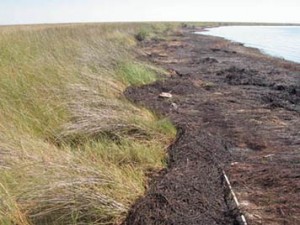
After the 2010 Deepwater Horizon spill, a heavy layer of oiled vegetation mats were preventing the thick emulsified oil underneath from breaking down along Barataria Bay’s marshes. (NOAA/Scott Zengel)
Coastal wetland vegetation is essential to the coastal area because it provides a barrier for the local community, a nursery habitat for juvenile organisms, and a highly productive environment for the marine life. This form of vegetation has a very high potential to come in contact with pollution, originating from inshore or offshore sources, because it is in areas usually separating ocean from land.
The most recent and notable offshore drilling incident was the BP Deepwater Horizon oil spill which was responsible for releasing millions of barrels of oil into the Gulf of Mexico and the surrounding coast. There are different types of oils and each has varying degrees of physical harm for proximal vegetation and soil, inducing and/or intensifying coastal erosion. The pollutant decays the root area of plants, creating a looser soil with a weaker support system.
This is a symbolic experiment for coastal wetland vegetation that may come in contact with light crude oil contamination (vegetable oil), heavier crude oil contamination (motor oil), or crude oil contamination in hypersaline environments. Light crude oil should be less harmful to wetlands in comparison to a heavier crude oil (more metal content) or even light crude oil in hypersaline areas (high salt content may absorb more water and nutrients from the plants, allowing for further smothering of the vegetation by oil).
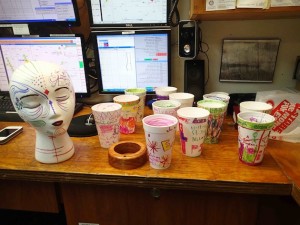 Laura Spencer, a graduate student in Dr. Steven DiMarco’s lab at Texas A&M University, took cups from three classrooms with her on the Gulf Integrated Spill Research Tracer cruise (G03) in the Gulf of Mexico. The cups were lowered in the water on one of the CTD casts. When the CDT was raised, the 5 inch cups shrank to half their original size.
Laura Spencer, a graduate student in Dr. Steven DiMarco’s lab at Texas A&M University, took cups from three classrooms with her on the Gulf Integrated Spill Research Tracer cruise (G03) in the Gulf of Mexico. The cups were lowered in the water on one of the CTD casts. When the CDT was raised, the 5 inch cups shrank to half their original size.
Dr. Steve DiMarco and his graduate student, Laura Spencer, visited two of the classes on 30 April 2013. The cups were returned to the students.
“Why do they shrink?” asked one of the students.
DiMarco used the cup demonstration to explain the property of pressure in the ocean to the students. The pressure on Earth’s surface is approximately 14.7 pounds per square inch. When the cup is lowered 3000 feet into the Gulf, pressure increased approximately Certificate100 times that of Earth’s surface, squeezing all the air out of the cup and reducing it to half its original size.
DiMarco presented a slide show to the students discussing the Deepwater Horizon oil spill. Topics included the fate of oil from the spill, effects of the oil spill on the Gulf ecosystem and what the Gulf Integrated Spill Research (GISR) consortium hopes to discover from their current research in the Gulf of Mexico. Spencer, who participated in the two GISR tracer cruises (G02 and G03), described what is was like to spend a month at sea doing research. The students were fascinated to learn about life at sea.
DiMarco and Spencer presented the students with certificates for participating as “student oceanographers” in the GISR G03 cruise.
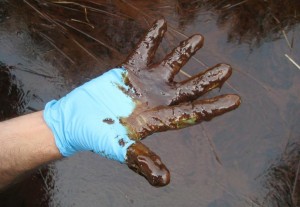
Oil from the Deepwater Horizon oil spill in the Gulf of Mexico impacts the coast at Pass a Loutre, La. Photo was taken on June 2, 2010.
(Credit: Office of the Governor of the State of Louisiana)
This web page from the Smithsonian Institution’s National Museum of Natural History’s Ocean Portal – a unique, interactive online experience that inspires awareness, understanding, and stewardship of the world’s Ocean – contains a wealth of information for educators, including lesson plans, materials, and resources on the Gulf oil spill.
Oilspillhub.org is an online resource for those studying the largest environmental disaster in U.S. history. The site provides an archive of the underwater video of the event, as well as additional tools and resources for educators, scientists, and engineers who are expanding our knowledge of environmental issues.
Oilspillhub.org is developed and hosted by Purdue University working in cooperation with the U.S. Senate Committee on Environment and Public Works and the House Select Committee on Energy Independence and Global Warming and the Energy and Environment Subcommittee in the House Energy and Commerce Committee.
Education resources are distributed across many websites and program offices at NOAA and on NOAA partner websites. This portal is designed to assist educators in accessing these materials from one centralized interface. The content here is a sampling of NOAA’s education resources and more can be found at each linked location. Materials selected for this site are organized by Themes, topical Collections, and content type that are aligned with common teaching topics and expressed needs of educators. Linked resources are organized into Collections which provide the user with a toolkit of materials and activities suitable for integration into a variety of educational settings. Collections are not grade specific but resources are labeled for grade appropriateness where applicable. Additional NOAA resources which support educator professional development, academic scholarship, career exploration, and education grants are also available. All materials linked from this site are free for use and distribution unless expressly noted.
http://www.education.noaa.gov/
The Bridge is a growing collection of the best marine education resources available on-line. It provides educators with a convenient source of accurate and useful information on global, national, and regional marine science topics, and gives researchers a contact point for educational outreach. Resources are organized as indicated on the sidebar on the left side of the screen.
Visit The Bridge website for more information.
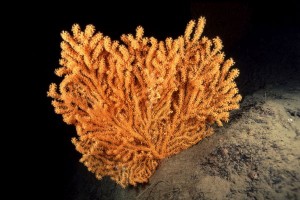
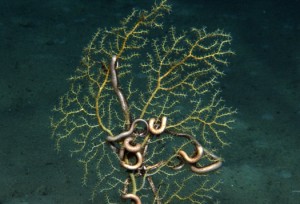 Deepwater coral reefs, aptly known as cold-water coral reefs, can be formed by the carbon created when bacteria biodegrade oil from natural seeps nearby. Oil spills can be easily devastating to coral reefs, ranging from the reefs at the surface of the water, directly subsurface, and even cold-water corals. Continue reading
Deepwater coral reefs, aptly known as cold-water coral reefs, can be formed by the carbon created when bacteria biodegrade oil from natural seeps nearby. Oil spills can be easily devastating to coral reefs, ranging from the reefs at the surface of the water, directly subsurface, and even cold-water corals. Continue reading
Scientists conducting GoMRI-funded oil spill research take their mission regarding society seriously:
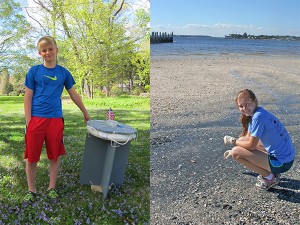
Left: 12-year old Kevin Telfer from Boston, MA, with the prototype drifter buoy he and a fellow science partner Harrison Reiter built and field tested for their science fair project titled, “Deployment of a Drifter Buoy in the Sudbury River: Prototype Design and Results.” (Photo by Brian Telfer) Right: High school sophomore Elizabeth Smithwick from Jacksonville, FL, collects soil samples along the St. Johns River for her science fair project titled, “The Isolation, Examination, and Comparison of Hydrocarbon Degrading Bacteria in the St. Johns River.” (Photo provided by Elizabeth Smithwick)
They employ cutting-edge technology to collect and analyze data using rigorous scientific parameters and publish their findings. But there are other ways these researchers define success, like working with students. When young students seek answers to scientific questions and contact them, these scientists experience a special type of accomplishment and fulfillment. Two GoMRI-funded researchers shared their experiences working closely with middle and high school students who initiated contact with them for help on science fair projects. Continue reading
All the world’s a stage – literally – as oceanic, atmospheric, and geologic conditions and events come to life on a “revolving” globe.
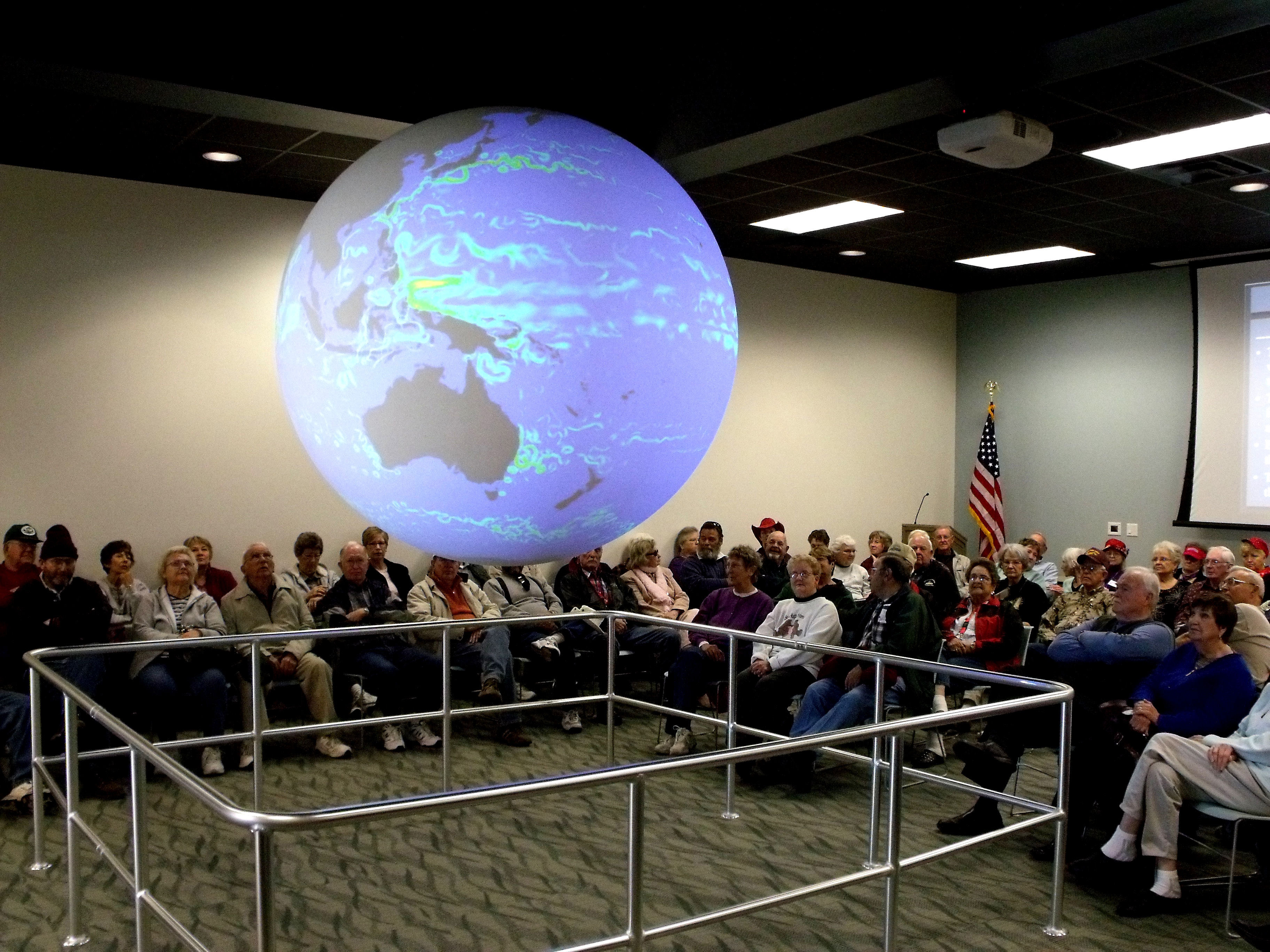
General public visitors attend a Science on a Sphere presentation at the Bay Education Center. (Photo by Jackie Hattenbach)
Researchers and science educators are using visualizations of oil spills, tsunamis, and hurricanes combined with science-based narratives to demonstrate the complex connectivity among Earth systems. The animated presentation of science in a world-wide context may grow public support for and inspire students to pursue interdisciplinary research that aims to improve response to future events.
With support from a Gulf of Mexico Research Initiative (GOMRI) award, the Dispersion Research on Oil: Physics and Plankton Studies (DROPPS) consortium led by Dr. Edward Buskey with the University of Texas Marine Science Institute (UTMSI) has partnered with the UTMSI Bay Education Center to incorporate up-to-date oil-spill and ocean research with the NOAA Science on a Sphere exhibit in order to reach a broad public audience.
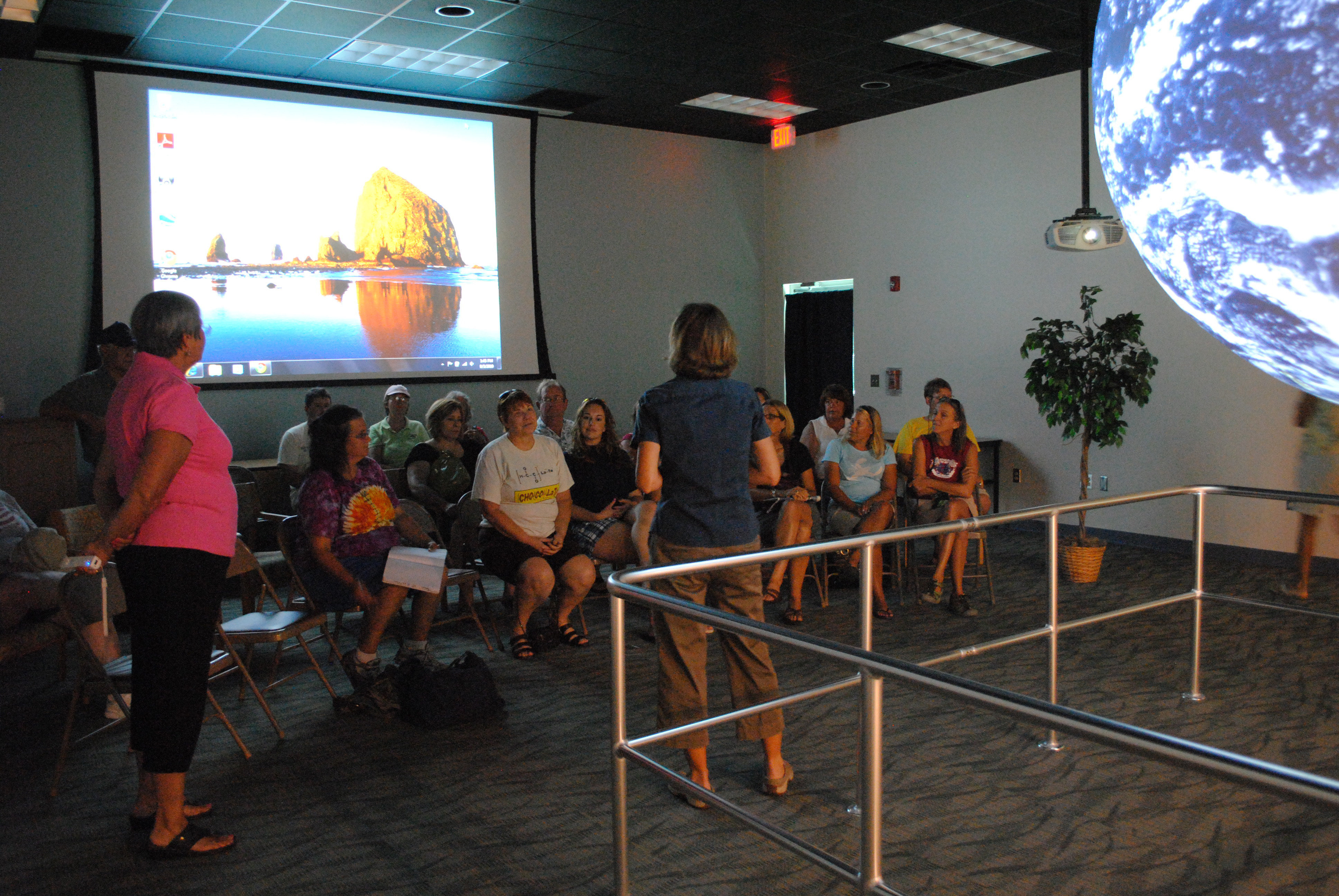
K-12 educators learn about the teaching potential of Science on a Sphere at a professional development workshop. (Photo by John Williams)
“Science on a Sphere can take this large, abstract phenomenon and make it accessible. The large format, global view really enables you to get a sense of the scale and movement of the Deepwater Horizon spill in a way that is much more intuitive than looking at a two-dimensional map or even a series of maps,” explains Dr. Deana Erdner a UTMSI Associate Professor and DROPPS outreach coordinator. “In addition, the Sphere is beautiful – it really draws people in, which means that we can get the information and the ideas out to far more people than we could with a static display.”
The DROPPS outreach team is in the initial development stage of preparing narratives using cutting-edge ocean surface currents and temperature science. As they more fully develop these narratives, they will pair them with NOAA and NASA datasets to create a powerful audio-visual teaching resource. The animation below is an example of how NOAA satellite data are used to show the daily movement of surface oil from the Deepwater Horizon incident from April 23 to August 2, 2010 and the locations affected.
(Above) Science on a Sphere Oil Spill Animation. Note: No audio. (Credit: NOAA)
DROPPS is pursuing collaboration with other GoMRI-funded consortia to incorporate new datasets into future Science on a Sphere presentations.
Last year, over 1,000 K-12 school children and 10,000 members of the general public attended UTMSI Science on a Sphere presentations. There are 82 exhibits around the world; 53 of them in the United States. All exhibits will have access to the science narratives that DROPPS is developing using the NOAA Deepwater Horizon dataset. This collaborative effort extends the availability of DROPPS outreach to a world-wide audience.

Children from Sea Camp attend a Science on a Sphere program at the Bay Education Center. (Photo by Carolyn Rose)
In addition to the exhibit presentations, the DROPPS outreach team incorporates oil-spill research in teacher workshops and when speaking to visiting K-12 groups. A middle school biology teacher who attended a presentation said, “The globe is awesome. I think students are really going to enjoy that. I’m looking forward to as many away-from-school and out-of-the-box learning situations that I can find.”
The DROPPS program includes six research institutions in five U.S. states and Norway. Scientists are investigating and modeling key processes involved with the dispersion of oil spills, interactions of oil with marine organisms and bacteria, and the environmental impact of these interactions. The experimental and numerical studies are performed at varying scales and levels of complexity, from bench-top studies to characterize specific phenomena to meso-scale experiments that are essential for mimicking realistic physical and biological conditions. The overall goals of these studies are to understand the fate of oil in the Gulf of Mexico; to provide data sets/predictive models to assess the environmental impact; and, via profiling of toxic compounds related to oil spills, to assess public health implications of oil spills in the Gulf.
This research is made possible by a grant from BP/The Gulf of Mexico Research Initiative. The GoMRI is a 10-year, $500 million independent research program established by an agreement between BP and the Gulf of Mexico Alliance to study the effects of the Deepwater Horizon incident and the potential associated impact of this and similar incidents on the environment and public health.